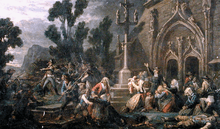Maximilien Robespierre
Maximilien François Marie Isidore de Robespierre (French: [mak.si.mi.ljɛ̃ fʁɑ̃.swa ma.ʁi i.zi.dɔʁ də ʁɔ.bɛs.pjɛʁ]; 6 May 1758 – 28 July 1794) was a French lawyer and statesman who was one of the best-known and most influential figures of the French Revolution. As a member of the Constituent Assembly and the Jacobin Club, he campaigned for universal manhood suffrage[1] and the abolition both of celibacy for the clergy, and slavery. In 1791, Robespierre became an outspoken advocate for the citizens without a political voice, for their unrestricted admission to the National Guard, to public offices, and for the right to carry arms in self-defence.[2][3][4] He played an important part in the agitation which brought about the fall of the French monarchy on 10 August 1792 and the summoning of a National Convention.[5] His goal was to create a united and indivisible France, equality before the law, to abolish prerogatives and to defend the principles of direct democracy.[6]
Maximilien de Robespierre | |
|---|---|
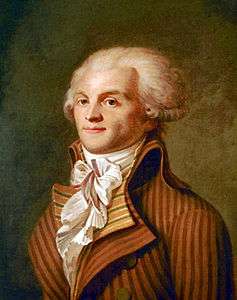 Robespierre c. 1790 (anonymous), Musée Carnavalet, Paris | |
| Member of the Committee of Public Safety | |
| In office 27 July 1793 – 28 July 1794 | |
| Preceded by | Thomas-Augustin de Gasparin |
| Succeeded by | Jacques Nicolas Billaud-Varenne |
| In office 25 March 1793 – 3 April 1793 member of the Commission of Public Safety | |
| 24th President of the National Convention | |
| In office 4 June 1794 – 19 June 1794 | |
| Preceded by | Claude-Antoine Prieur-Duvernois |
| Succeeded by | Élie Lacoste |
| In office 22 August 1793 – 7 September 1793 | |
| Preceded by | Marie-Jean Hérault de Séchelles |
| Succeeded by | Jacques-Nicolas Billaud-Varenne |
| Deputy of the National Convention | |
| In office 20 September 1792 – 27 July 1794 | |
| Constituency | Paris |
| Deputy of the National Constituent Assembly | |
| In office 9 July 1789 – 30 September 1791 | |
| Constituency | Artois |
| Deputy of the National Assembly | |
| In office 17 June 1789 – 9 July 1789 | |
| Constituency | Artois |
| Deputy to the Estates General for the Third Estate | |
| In office 6 May 1789 – 16 June 1789 | |
| Constituency | Artois |
| President of the Jacobin Club | |
| In office 31 March – 3 June 1790 | |
| In office 7 August – 28 August 1793 | |
| Personal details | |
| Born | Maximilien François Marie Isidore de Robespierre 6 May 1758 Arras, Artois, France |
| Died | 28 July 1794 (aged 36) Place de la Révolution, Paris, France |
| Cause of death | Execution by guillotine |
| Political party | The Mountain (1792–1794) |
| Other political affiliations | Jacobin Club (1789–1794) |
| Alma mater | Collège Louis-le-Grand University of Paris |
| Profession | Lawyer and politician |
| Signature | |
As one of the leading members of the insurrectionary Paris Commune, Robespierre was elected as a deputy to the French Convention in early September 1792 but was soon criticised for trying to establish either a triumvirate or a dictatorship. In November Condorcet considered the French Revolution as a religion and Robespierre had all the characteristics of a leader of a sect,[7][8] or a cult.[9] In April 1793, he urged the creation of a sans-culotte army to enforce revolutionary laws and sweep away any counter-revolutionary conspirator, leading to the armed Insurrection of 31 May – 2 June 1793. In July he was appointed as a member of the powerful Committee of Public Safety, and reorganized the Revolutionary Tribunal. In October, after Robespierre proposed in vain to close the convention, the Committee declared itself as revolutionary government. Those who were not actively defending France became his enemy.[10] He exerted his influence to suppress the Girondins to the right, the Hébertists to the left and then the Dantonists in the centre.
Robespierre is best known for his role as a member of the Committee of Public Safety as he personally signed 542 arrests, especially in spring and summer 1794.[11][lower-alpha 1] The question of Robespierre's responsibility for the law of 22 Prairial will always be controversial.[12] It removed the few procedural guarantees still afforded to the accused. Moreover, the cult of the Supreme Being dear to Robespierre was suspect in the eyes of the anticlericals.[13] Robespierre was eventually undone by his obsession with the vision of an ideal republic and his indifference to the human costs of installing it, which turned both members of the Convention and the French public against him.[14] The Reign of Terror ended when he and fifty of his allies were arrested in the Paris' town hall on 9 Thermidor. Robespierre was wounded in his jaw, but it is not known if it was self-inflicted or the outcome of the skirmish. About 90 people were executed in the days after; events that initiated a period known as the Thermidorian Reaction.[15] Robespierre, who embodied the civil war and the Terror, was excluded from being buried in the Panthéon.
To some, Robespierre was the Revolution's principal ideologist and embodied the country's first democratic experience, marked by the often revised and never implemented French Constitution of 1793. To others, he was the incarnation of the Terror that followed during Year II of the French Revolutionary calendar.[16]
Early life
Maximilien de Robespierre was born in Arras in the old French province of Artois. His family has been traced back to the 15th century in Vaudricourt, Pas-de-Calais; one of his ancestors, Robert de Robespierre, worked as a notary in Carvin the mid-17th century.[17] His paternal grandfather, also named Maximilien de Robespierre, established himself in Arras as a lawyer. His father, François Maximilien Barthélémy de Robespierre, was a lawyer at the Conseil d'Artois who married the pregnant Jacqueline Marguerite Carrault, the daughter of a brewer. Maximilien was the eldest of four children and was conceived out of wedlock. His siblings were Charlotte (1760–1834),[lower-alpha 2] Henriette (1761–1780),[lower-alpha 3] and Augustin (1763–1794).[18][19]
Early in July 1764, Madame de Robespierre gave birth to a stillborn daughter; she died twelve days later, at the age of 29. Devastated by his wife's death, François de Robespierre left Arras around 1767.[lower-alpha 4] His two daughters were brought up by their paternal aunts, and his two sons were taken in by their maternal grandparents.[20] Already literate at age eight, Maximilien started attending the collège of Arras (middle school).[21] In October 1769, on the recommendation of the bishop fr:Louis-Hilaire de Conzié, he received a scholarship at the Collège Louis-le-Grand. His fellow pupils included Camille Desmoulins and Stanislas Fréron. In school, he learned to admire the idealised Roman Republic and the rhetoric of Cicero, Cato and Lucius Junius Brutus. He also studied the works of the Genevan philosophe Jean-Jacques Rousseau and was attracted to many ideas, written in his "Contrat Social". Robespierre became intrigued by the idea of a "virtuous self", a man who stands alone accompanied only by his conscience.[22] His study of the classics prompted him to aspire to Roman virtues, but he sought to emulate Rousseau's citizen-soldier in particular.[23][24] Robespierre's conception of revolutionary virtue and his programme for constructing political sovereignty out of direct democracy came from Montesquieu, Rousseau, and Mably.[25][lower-alpha 5] With Rousseau, Robespierre considered the "volonté générale" or the general will of the people as the basis of political legitimacy.[29]
Early politics
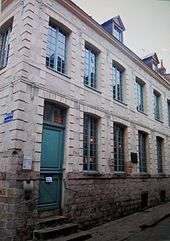
Robespierre studied law for three years at the University of Paris. Upon his graduation on 31 July 1780, he received a special prize of 600 livres for exemplary academic success and personal good conduct.[30] On 15 May 1781, Robespierre gained admission to the bar. The bishop of Arras, Hilaire de Conzié, appointed him as one of the five judges in the criminal court in March 1782. Robespierre soon resigned, owing to discomfort in ruling on capital cases arising from his early opposition to the death penalty. His most famous case took place in May 1783 and involved a lightning rod in St. Omer. His defence was printed and he sent Benjamin Franklin a copy.[31]
On 15 November 1783, he was elected a member of the literary Academy of Arras.[32] In 1784 the Academy of Metz awarded him a medal for his essay on the question of whether the relatives of a condemned criminal should share his disgrace, which made him a man of letters.[33] He and Pierre Louis de Lacretelle, an advocate and journalist in Paris, divided the prize. Robespierre attacked inequality before the law, the indignity of natural children, the lettres de cachet (getting arrested without a trial) and the sidelining of women in academic life. Robespierre had particularly that of Louise-Félicité de Kéralio in mind.[34] As president of the academy he became acquainted with the revolutionary journalist Gracchus Babeuf, the young officer and engineer Lazare Carnot and with the teacher Joseph Fouché.[35] Robespierre claimed to have seen Rousseau, shortly before he died.[36][37][38]
In August 1788, King Louis XVI announced new elections for all provinces and a gathering of the Estates-General for 1 May 1789 to solve France's serious financial and taxation problems. Robespierre participated in a discussion regarding how the French provincial government should be elected, arguing in his Address to the Nation of Artois that if the former mode of election by the members of the provincial estates was again adopted, the new Estates-General would not represent the people of France. In late February 1789, France saw a pressing crisis due to its desire for a new constitution, according to Gouverneur Morris.[39]
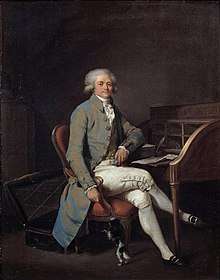
In his electoral district, Robespierre began to make his mark in politics with his Notice to the Residents of the Countryside of 1789 in which he attacked the local authorities.[lower-alpha 6] With this, he secured the support of the country electors. On 26 April 1789, Robespierre was elected as one of 16 deputies for Pas-de-Calais to the Estates-General; others were Charles de Lameth and Albert de Beaumetz.[41] [lower-alpha 7] When the deputies arrived at Versailles they were presented to the king and listened to Jacques Necker's three-hour-long speech about institutional and political reforms.[42] They were informed that all voting would be "by order" not "by head", so their double representation as promised in December 1788 was to be meaningless.[43][44] It resulted in Abbé Sieyès opposing the veto of the King, suggesting the Third Estate to meet separately and changing its name.[45] On 13 June, Robespierre joined the deputies, who would call themselves the National Assembly representing 96% of the nation.[46] On 9 July, the Assembly moved to Paris. It transformed itself into the National Constituent Assembly to discuss a new constitution and taxation system.
On 13 July, the Assembly proposed to reestablish the "bourgeois militia" to control the riots.[47] On 14 July, the people demanded arms and stormed the Hotel des Invalides and the Bastille. On the same day the National Guard was created in Paris,[48] keeping the very poorest citizens at arm's length.[49] Marquis de La Fayette was acclaimed their commander-in-chief.[50] On 20 July, the Assembly decided to establish National Guards in every commune in the country.[51][52] The Gardes Françaises were admitted and supported to elect "new chefs".[53] Discussing the matter Robespierre defended the citizens who had no access to it.[54][55]
In October he was one of the few who supported Maillard after the Women's March on Versailles.[56] While the Constituent Assembly occupied itself with male census suffrage, Robespierre and a few more deputies opposed the property requirements for voting and holding office.[57] In December and January Robespierre succeeded in attracting the attention of the excluded classes, particularly Protestants in France, Jews,[58] blacks, servants and actors.[59][60]
As a frequent speaker in the Assembly, Robespierre voiced many ideas in support of the Declaration of the Rights of Man (1789) and constitutional provisions for the Constitution of 1791 but rarely attracted a majority among fellow deputies, according to Malcolm Crook.[61][62] Robespierre, who never gave up wearing a culotte and always 'poudré, frisé, et parfumé', seems to have been nervous, timid and suspicious. Madame de Staël described Robespierre as 'very exaggerated in his democratic principles'. He supported the most absurd propositions with a coolness that had the air of conviction.[63]
Jacobin Club
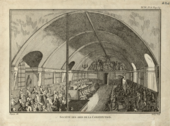
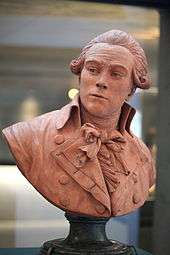
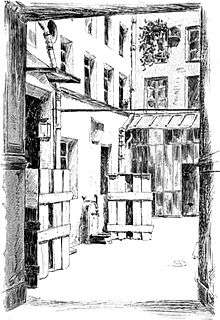
From October 1789, Robespierre lived at 9, Rue de Saintonge in Le Marais.[65] Pierre Villiers claimed he was his secretary for several months, and they shared the apartment on the third floor.[66] Robespierre associated with the new Society of the Friends of the Constitution, commonly known as the Jacobin Club. Originally, this organization (the Club Breton) comprised only deputies from Brittany, but after the National Assembly had moved to Paris, the Friends admitted non-deputies, supporting the changes in France. As time went on, many of the more educated artisans and small shopkeepers joined the Jacobin club.[67] Among these 1,200 men, Robespierre found a sympathetic audience. Equality was the keystone of the Jacobin ideology. In January he held several speeches in response to the decision making the exercise of civil rights dependent on a certain sum in the tax. During the debate on the suffrage, Robespierre ended his speech of 25 January 1790 with a blunt assertion that ‘all Frenchmen must be admissible to all public positions without any other distinction than that of virtues and talents’.[68] He began to acquire a reputation, and on 31 March 1790 Robespierre was elected as their president.[69] On 28 April Robespierre proposed to allow an equal number of officers and soldiers in the court martial.[70] On 11 May he supported the cooperation of all the National Guards in a general federation.[71] On 19 June he was elected secretary of the National Assembly.
In Spring 1790 the departments of France were reorganized; the Commune was divided up in 48 sections and allowed to discuss the election of a new mayor. In July Robespierre demanded "fraternal equality" in salaries.[72] On 2 August Jean Sylvain Bailly became Paris' first elected mayor with 12.500 votes; Georges Danton had 49, Marat and Louis XVI only one.[73][74] Discussing the future of Avignon Robespierre and his supporters on the galleries succeeded in silencing Mirabeau. Before the end of the year, he was seen as one of the leaders of the small body of the extreme left. Robespierre was one of "the thirty voices", as Mirabeau referred to Barnave with contempt: "That man will go far—he believes everything he says."[75] On 5 December Robespierre delivered a speech on the urgent topic of the National Guard, a police force independent from the army.[76][77][78] "To be armed for personal defense is the right of every man, to be armed to defend freedom and the existence of the common fatherland is the right of every citizen".[79] Robespierre coined the famous motto "Liberté, égalité, fraternité" by adding the word fraternity on the flags of the National Guard.[lower-alpha 8][81][82]
On 18 December it was decreed to supply the National Guard with 50,000 fusils.[83] On 28 January Robespierre discussed the organisation of the National Guard in the Assembly;[84] for three years a hot topic in French newspapers.[85] Early March provincial militias were abolished and the Paris Department was placed above the Commune in all matters of general order and security. According to Jan ten Brink it had the right to suspend the Commune's decisions and to dispose of the army against her in case of emergency. On 27 and 28 April 1791, Robespierre opposed plans to reorganize the National Guard and restrict its membership to active citizens.[86][87] It was regarded as too aristocratic. He demanded the reconstitution of the National Guard on a democratic basis.[88] He felt that the National Guard had to become the instrument of defending liberty and no longer be a threat to it.[89][90]
On 9 May, the Assembly discussed the right to petition.[91] Article III specifically recognised the right of active citizens to meet together to draw up petitions and addresses and present them to municipal authorities.[92] On 16–18 May when the elections began, Robespierre proposed and carried the motion that no deputy who sat in the Constituent assembly could sit in the succeeding Legislative assembly.[93] The principal tactical purpose of this self-denying ordinance was to block the ambitions of the old leaders of the Jacobins, Antoine Barnave, Adrien Duport, and Alexandre de Lameth,[94] aspiring to create a constitutional monarchy roughly similar to that of England.[95][lower-alpha 9]
On 28 May, Robespierre proposed all Frenchmen should be declared active citizens and eligible to vote.[97] On 30 May, he delivered a speech on the abolishment of the death penalty but without success.[98] The following day, Robespierre attacked Abbé Raynal, who sent an address criticising the work of the Constituent Assembly and demanding the restoration of the royal prerogative.
On 10 June, Robespierre delivered a speech on the state of the army and proposed to dismiss officers.[89] On 11 June, he accepted the function of the public prosecutor in Paris.[99] On 13 June L'Ami du Roi, a royalist pamphlet, described Robespierre as a "lawyer for bandits, rebels and murderers".[76] On 14 June, the abolition of the guild system was sealed; the Le Chapelier Law prohibited any kind of workers' coalition or assembly. (It concerned in the first instance as much collective petitioning by the political clubs as trade associations.[100]) Proclaiming free enterprise as the norm upset Jean-Paul Marat, but not the urban labourer nor Robespierre.[101] On 15 June, Pétion became president of the "tribunal criminel provisoire", after Duport refused to work with Robespierre.[102]
After Louis XVI's failed flight to Varennes, the Assembly decreed that the king be suspended from his duties on 25 June until further notice. Between 13–15 July the Assembly debated the restoration of the king and his constitutional rights.[103] Robespierre declared in the Jacobin Club on 13 July: The current French constitution is a republic with a monarch.[104] It is therefore neither a monarchy nor a republic. She is both.[105] The crowd on the Champ de Mars approved a petition calling for the king's trial. Alarmed at the progress of the Revolution, the moderate Jacobins in favour of a constitutional monarchy founded the club of the Feuillants on the next day, taking with them 264 deputies. In the evening, the King was restored in his functions.
On Saturday 17 July, Bailly and La Fayette declared a ban on gathering followed by martial law.[106][107] After the Champ de Mars massacre, the authorities ordered numerous arrests. Robespierre, who attended the Jacobin club, did not dare to go back to the rue Saintonge where he lodged, and so asked Laurent Lecointre if he knew a patriot near the Tuileries who could put him up for the night. Lecointre suggested Duplay's house and took him there.[108] Maurice Duplay, a cabinetmaker and ardent admirer, lived at 398 Rue Saint-Honoré near the Tuileries. After a few days, Robespierre decided to move in permanently, although he lived in the backyard and he was constantly exposed to the sound of working.[109] He was motivated by a desire to live closer to the Assembly and the meeting place of the Jacobins in the rue Saint-Honoré. [lower-alpha 10] According to his friend, the surgeon Joseph Souberbielle, Joachim Vilate, and Duplay's daughter Élisabeth, Robespierre became engaged to Duplay's eldest daughter Éléonore, but his sister Charlotte vigorously denied this; also his brother Augustin refused to marry her.[110][111][112]
On 3 September, the French Constitution of 1791 was installed. On 29 September, the day before the dissolution of the Assembly, Robespierre opposed Jean Le Chapelier, who wanted to proclaim an end to the revolution and restrict the freedom of the clubs. Robespierre had been carefully preparing for this confrontation and it was the climax of his political career up to this point.[113] Pétion and Robespierre were brought back in triumph to their homes. On 16 October, Robespierre held a speech for the Jacobins in Arras; one week later in Béthune and Lille. On 28 November, he was back in the Jacobin club, where he met with a triumphant reception. Collot d'Herbois gave his chair to Robespierre, who presided that evening.
Opposition to war with Austria
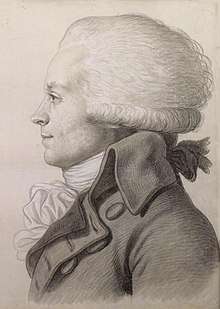
As Marat, Danton and Robespierre were not elected in the new legislature thanks to the Self-Denying Ordinance, oppositional politics often took place outside the Assembly. On 18 December 1791, Robespierre gave a (second) speech at the Jacobin club against the declaration of war.[115] Robespierre warned against the threat of dictatorship stemming from war, in the following terms:
If they are Caesars, Catilinas or Cromwells, they seize power for themselves. If they are spineless courtiers, uninterested in doing good yet dangerous when they seek to do harm, they go back to lay their power at their master's feet and help him to resume arbitrary power on condition they become his chief servants.[116]
On 25 December, Guadet, the chairman of the Assembly, suggested that 1792 should be the first year of universal liberty.[117] Jacques Pierre Brissot stated on 29 December that a war would be a benefit to the nation and boost the economy. He urged that France should declare war against Austria. Marat and Robespierre opposed him, arguing that victory would create a dictatorship, while defeat would restore the king to his former powers; neither end, he said, would serve the revolution.[118]
The most extravagant idea that can arise in a politician's head is to believe that it is enough for a people to invade a foreign country to make it adopt their laws and their constitution. No one loves armed missionaries... The Declaration of the Rights of Man... is not a lightning bolt which strikes every throne at the same time... I am far from claiming that our Revolution will not eventually influence the fate of the world... But I say that it will not be today (2 January 1792).[119]
This opposition from expected allies irritated the Girondins, and the war became a major point of contention between the factions. In his third speech on the war, Robespierre countered in the Jacobin club, "A revolutionary war must be waged to free subjects and slaves from unjust tyranny, not for the traditional reasons of defending dynasties and expanding frontiers..." Indeed, argued Robespierre, such a war could only favour the forces of counter-revolution, since it would play into the hands of those who opposed the sovereignty of the people. The risks of Caesarism were clear, for, in wartime, the powers of the generals would grow at the expense of ordinary soldiers, and the power of the king and court at the expense of the Assembly. These dangers should not be overlooked, he reminded his listeners; "...in troubled periods of history, generals often became the arbiters of the fate of their countries."[120] Already, Robespierre knew that he had lost, as he failed to gather a majority. His speech was nevertheless published and sent to all clubs and Jacobin societies of France.[121]
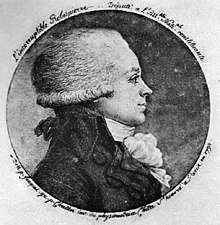
On 10 February 1792, he gave a speech on how to save the State and Liberty and did not use the word war. He began by assuring his audience that everything he intended to propose was strictly constitutional. He then went on to advocate specific measures to strengthen, not so much the national defences as the forces that could be relied on to defend the revolution.[124] Not only the National Guard but also the people had to be armed, if necessary with pikes. Robespierre promoted a people's army, continuously under arms and able to impose its will on Feuillants and Girondins in the Constitutional Cabinet of Louis XVI and in the Legislative Assembly.[125] The Jacobins decided to study his speech before deciding whether it should be printed.[126]
The Girondins planned strategies to out-manoeuvre Robespierre's influence among the Jacobins.[127] He was accused by Brissot and Guadet of trying to become the idol of the people.[128] On 26 March, Guadet accused Robespierre of superstition, relying on divine providence;[129] being against the war he was also accused of acting as a secret agent for the Austrian Committee.[130] On 10 April, Robespierre resigned the post of public prosecutor, which he had officially held since 15 February.[131] He explained his resignation to the Jacobin Club, on 27 April, as part of his speech responding to the accusations against him. He threatened to leave the Jacobins, claiming he preferred to continue his mission as an ordinary citizen.[132]
On 17 May, Robespierre published the first issue of his journal Le Défenseur de la Constitution (The Defender of the Constitution), in which he attacked Brissot and publicised his scepticism over the whole war movement.[133][134] The journal served multiple purposes: to print his speeches, to counter the influence of the royal court in public policy, to defend him from the accusations of Girondist leaders and to give voice to the economic and democratic interests of the broader masses in Paris and defend their rights.[135][136]
The insurrectionary Commune of Paris
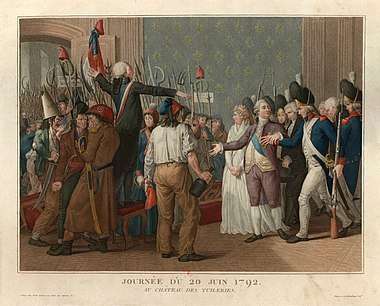
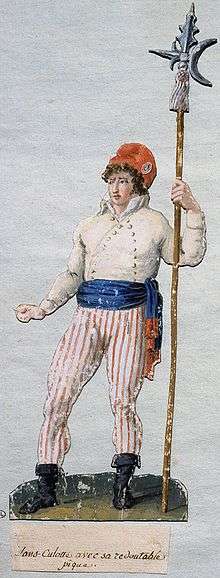
When the Legislative Assembly declared war against Austria on 20 April 1792, Robespierre stated that the French people must rise and arm themselves completely, whether to fight abroad or to keep a lookout for despotism at home.[137] On 23 April Robespierre demanded Marquis de Lafayette to step down. Robespierre responded by working to reduce the political influence of the officer class and the king. While arguing for the welfare of common soldiers, Robespierre urged new promotions to mitigate the domination of the officer class by the aristocratic and royalist École Militaire and the conservative National Guard.[lower-alpha 11] Along with other Jacobins, he urged in the fifth issue of his magazine the creation of an "armée révolutionnaire" in Paris, consisting of at least 20,000 men,[139] to defend the city, "liberty" (the revolution), maintain order in the sections and educate the members in democratic principles; an idea he borrowed from Jean-Jacques Rousseau.[140] According to Jean Jaures, he considered this even more important than the right to strike.[88]
On 29 May 1792, the Assembly dissolved the Constitutional Guard, suspecting it of royalist and counter-revolutionary sympathies. In early June 1792, Robespierre proposed an end to the monarchy and the subordination of the Assembly to the General will.[141] Following the king's veto of the Assembly's efforts to suppress nonjuring priests on 27 May, on proposal of Carnot and Servan in the Assembly to raise a (permanent) militia of volunteers on 8 June,[142] and the reinstatement of Brissotin ministers dismissed on 18 June, the monarchy faced an abortive demonstration of 20 June.[143] Sergent-Marceau and Panis, the administrators of police, were sent out by Pétion to urge the Sans-culottes to lay down their weapons, telling them it was illegal to present a petition in arms (to demand the king to apply the constitution, accept the decrees, and recall the ministers). Their march to the Tuileries was not banned. They invited the officials to join the procession and march along with them.[144]
Because French forces suffered disastrous defeats and a series of defections at the onset of the war, Robespierre and Marat feared the possibility of a military coup d'état. One was led by the Lafayette, head of the National Guard, who at the end of June advocated the suppression of the Jacobin Club. Robespierre publicly attacked him in scathing terms:
"General, while from the midst of your camp you declared war upon me, which you had thus far spared for the enemies of our state, while you denounced me as an enemy of liberty to the army, National Guard and Nation in letters published by your purchased papers, I had thought myself only disputing with a general... but not yet the dictator of France, arbitrator of the state."[145]
On 2 July, the Assembly authorized the National Guard to go to the Festival of Federation on 14 July, thus circumventing a royal veto. On 11 July, the Jacobins won an emergency vote in the wavering Assembly, declaring the nation in danger and drafting all Parisians with pikes into the National Guard.[146] (Meanwhile, Fédérés entered the city for the celebration of 14 July.) On 15 July, Billaud-Varenne in the Jacobin club outlined the program following the uprising; the deportation of all the Bourbons, the cleansing of the National Guard, the election of a Convention, the "transfer of the Royal veto to the people", the deportation of all "enemies of the people" and exemption of the poorest from taxation. This sentiment reflected the perspective of more radical Jacobins including those of the Marseille Club, who wrote to the deposed mayor Pétion and the people of Paris, "Here and at Toulon, we have debated the possibility of forming a column of 100,000 men to sweep away our enemies... Paris may have need of help. Call on us!" [147]
A few days later the news of the Brunswick Manifesto began sweeping through Paris. It was frequently described as unlawful and offensive to national sovereignty.[148] On 1 August the Assembly voted on Carnot's proposal and ordered the municipalities that pikes should be issued to all citizens, except vagabonds, etc.[149][150][151] On 3 August Pétion and 47 sections demanded the deposition of the king. On 4 August the government planned to evade; during the night volunteers from Marseille moved into the Cordeliers Convent. On 5 August Robespierre announced the uncovering of a plan for the king to escape to Château de Gaillon.[152] On 7 August Pétion suggested to Robespierre to contribute to the departure of Fédérés to appease the capital.[153] The Council of Ministers suggested arresting Danton, Marat and Robespierre if they visited the Jacobin club.[154] On 9 August, when the Assembly refused to impeach LaFayette, the tocsin called the sections into arms.[155] In the evening the "commissionaires" of several sections (Billaud-Varenne, Chaumette, Hébert, Hanriot, Fleuriot-Lescot, Pache, Bourdon) gathered in the town hall. At midnight the municipal government of the city was dissolved. Sulpice Huguenin, head of the sans-culottes of the Faubourg Saint-Antoine, was appointed provisional president of the Insurrectionary Commune.
Early in the morning on (Friday, 10 August) 30,000 Fédérés (volunteers from the countryside) and Sans-culottes (militants from the Paris sections) led a successful assault upon the Tuileries;[156] according to Robespierre a triumph for the "passive" (non-voting) citizens. The frightened Assembly suspended the king and voted for the election of a National Convention to take its place.[157] On the night of 11 August Robespierre was elected to the Paris Commune as a representative for the "Section de Piques"; the district where he lived. The governing committee called for the summoning of a convention chosen by universal male suffrage,[158] to form a new government and reorganize France. On 13 August Robespierre declared himself against the strengthening of the départments.[159] On 14 August Danton invited him to join the Council of Justice. Robespierre published the twelfth and last issue of "Le Défenseur de la Constitution", both an account and political testament.[160] On 16 August, Robespierre presented a petition to the Legislative Assembly from the Paris Commune to demand the establishment of a provisional Revolutionary Tribunal that had to deal with the "traitors" and "enemies of the people". The next day Robespierre was appointed as one of eight judges, but he refused to preside over it.[161] He declined any position that might take him out of the political arena.[162] (Fouquier-Tinville was appointed as president.) The Prussian army crossed the French frontier on 19 August. The Paris armed sections were incorporated in 48 battalions of the National Guard under Santerre. The Assembly decreed that all the non-juring priests had to leave Paris within a week and the country within two weeks.[163] On 27 August, in the presence of almost half the population of Paris, a funeral ceremony was held on Place du Carrousel for the victims who were killed during storming the Tuileries.[164]
The passive citizens still strived for acceptance and the supply of weapons. Danton proposed that the Assembly should authorize house searches ‘to distribute to the defenders of the "Patrie" the weapons that indolent or ill-disposed citizens may be hiding’.[161] The section Sans-culottes organized it self as surveillance committee, conducting searches and making arrests all over Paris.[165][166] The gates were closed to prevent (royalist) suspects and deputies would leave the city. The raids began on 29 August which seem to have gone on for another two days.[161] Marat and Robespierre both disliked Condorcet who proposed that the "enemies of the people" belonged to the whole nation and should be judged constitutionally in its name.[167] A sharp conflict developed between the Legislative and the Commune and its sections.[168][162] On 30 August the interim minister of Interior Roland and Guadet tried to suppress the influence of the Commune because the sections had exhausted the searches. The Assembly, tired of the pressures, declared the Commune illegal and suggested the organization of communal elections.[169]
Robespierre was no longer willing to cooperate with Brissot, who promoted the Duke of Brunswick, and Roland, who proposed that the members of the government should leave Paris, taking the treasury and the king with it.[161] On Sunday morning 2 September the members of the Commune, gathering in the town hall to proceed the election of deputies to the National Convention, decided to maintain their seats and have Rolland and Brissot arrested.[170][171] Madame de Staël who tried to escape Paris was forced by the crowd to go to the town hall. She noted that Robespierre was in the chair that day, assisted by Collot d'Herbois and Billaud-Varenne as secretaries.[172]
The National Convention
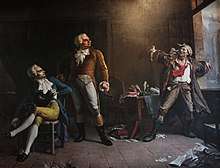
On 2 September 1792 French National Convention election began. At the same time, Paris was organizing its defence, but it was confronted with a lack of arms for the thousands of volunteers. Danton delivered a speech in the assembly and possibly referring to the (Swiss) inmates: “We ask that anyone who refuses to serve in person, or to surrender their weapons, is punished with death.[173][174] Not long after the September Massacres began.[175][176][177] Charlotte Corday held Marat responsible, Madame Roland Danton. Robespierre visited the Temple prison to check on the security of the royal family.[178] The next day on proposal of Collot d'Herbois the Assembly decided excluding royalist deputies from re-election to the Convention.[179] Robespierre made sure Brissot (and his fellow Brissotins Pétion and Condorcet) could not be elected in Paris.[180] According to Charlotte Robespierre, her brother stopped talking to his former friend, mayor Pétion de Villeneuve, who finally rallied to Brissot.[181] On 5 September, Robespierre was elected deputy to the National Convention but Danton and Collot d'Herbois received more votes than Robespierre.[lower-alpha 12] Madame Roland wrote to a friend: "We are under the knife of Robespierre and Marat, those who would agitate the people."[182]
On 21 September Pétion was elected as president of the convention; nearly all members were lawyers. The Jacobins and Cordeliers took the high benches at the back of the former Salle du Manège, giving them the label the "Montagnards", or "the Mountaineers"; below them were the "Manège" of the Girondists, moderate Republicans. The majority the Plain was formed by independents (as Barère, Cambon and Carnot) but dominated by the radical Mountain.[183] On 25 and 26 September, the Girondists Barbaroux and Lasource accused Robespierre of wanting to form a dictatorship.[184] Danton was asked to resign as minister as he was also a deputy. Rumours spread that Robespierre, Marat and Danton were plotting to establish a triumvirate to save the First French Republic. (From October 1791 until September 1792 the French Legislative Assembly saw an unprecedented turnover of four ministers of Justice, four ministers of Navy, six ministers of the interior, seven ministers of foreign affairs, and eight ministers of war.[185]) On 30 September Robespierre advocated for better laws; the registration of marriages, births and burials was withdrawn from the church. On 29 October, Louvet de Couvrai attacked Robespierre.[186] He accused him of star allures,[187] and have done nothing to stop the September massacre; instead, he had used it to have more Montagnards elected.[188] Robespierre, who seems to have been sick was given a week to respond. On 5 November, Robespierre defended himself, the Jacobin Club and his supporters in and beyond Paris:
Upon the Jacobins, I exercise, if we are to believe my accusers, a despotism of opinion, which can be regarded as nothing other than the forerunner of dictatorship. Firstly, I do not know what a dictatorship of opinion is, above all in a society of free men... unless this describes nothing more than the natural compulsion of principles. This compulsion hardly belongs to the man who enunciates them; it belongs to universal reason and to all men who wish to listen to its voice. It belongs to my colleagues of the Constituent Assembly, to the patriots of the Legislative Assembly, to all citizens who will invariably defend the cause of liberty. Experience has proven, despite Louis XVI and his allies, that the opinion of the Jacobins and the popular clubs were those of the French Nation; no citizen has made them, and I did nothing other than share in them.[189]
Turning the accusations upon his accusers, Robespierre delivered one of the most famous lines of the French Revolution to the Assembly:
I will not remind you that the sole object of contention dividing us is that you have instinctively defended all acts of new ministers, and we, of principles; that you seemed to prefer power, and we equality... Why don't you prosecute the Commune, the Legislative Assembly, the Sections of Paris, the Assemblies of the Cantons and all who imitated us? For all these things have been illegal, as illegal as the Revolution, as the fall of the Monarchy and of the Bastille, as illegal as liberty itself... Citizens, do you want a revolution without a revolution? What is this spirit of persecution which has directed itself against those who freed us from chains?[190]
As his opponents knew well, Robespierre had a strong base of support among the women of Paris. John Moore (Scottish physician) was sitting in the galleries, and noted that the audience was ‘almost entirely filled with women’.[191][192] He is a priest who has his devotees but it is evident that all of his power lies in the distaff. Robespierre tried to appeal to women because in the early days of the Revolution when he had tried to appeal to men, he had failed.[191] The Girondines called on the local authorities to oppose the concentration and centralization of power.
Execution of Louis XVI
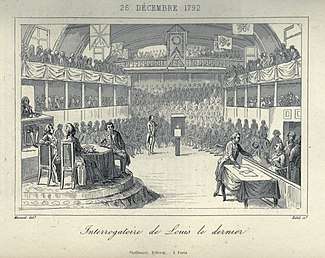
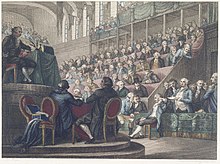
The convention's unanimous declaration of a French Republic on 21 September 1792 left the fate of the former king open to debate. A commission was therefore established to examine the evidence against him while the convention's Legislation Committee considered legal aspects of any future trial. Most Montagnards favoured judgment and execution, while the Girondins were more divided concerning how to proceed, with some arguing for royal inviolability, others for clemency, and others advocating lesser punishment or banishment.[193] On 13 November Robespierre stated in the Convention that a Constitution which Louis had violated himself, and which declared his inviolability, could not now be used in his defence.[194] Robespierre had been taken ill and had done little other than support Saint-Just, a former colonel in the National Guard, who gave his first major speech to address and argue against the king's inviolability. On 20 November, opinion turned sharply against Louis following the discovery of a secret cache of 726 documents consisting of Louis's personal communications with bankers and ministers.[195] At his trial, he claimed not to recognize documents clearly signed by himself.[196]
With the question of the king's fate now occupying public discourse, Robespierre delivered on 3 December a speech that would define the rhetoric and course of Louis's trial.[197] All the deputies from the Mountain were asked to attend. Robespierre argued that the dethroned king could now function only as a threat to liberty and national peace and that the members of the Assembly were not to be impartial judges but rather statesmen with responsibility for ensuring public safety:
Louis was a king, and our republic is established; the critical question concerning you must be decided by these words alone. Louis was dethroned by his crimes; Louis denounced the French people as rebels; he appealed to chains, to the armies of tyrants who are his brothers; the victory of the people established that Louis alone was a rebel; Louis cannot, therefore, be judged; he already is judged. He is condemned, or the republic cannot be absolved. To propose to have a trial of Louis XVI, in whatever manner one may, is to retrogress to royal despotism and constitutionality; it is a counter-revolutionary idea because it places the revolution itself in litigation. In effect, if Louis may still be given a trial, he may be absolved, and innocent. What am I to say? He is presumed to be so until he is judged. But if Louis is absolved, if he may be presumed innocent, what becomes of the revolution? If Louis is innocent, all the defenders of liberty become slanderers. [198]
In arguing for a judgment by the elected Convention without trial, Robespierre supported the recommendations of Jean-Baptiste Mailhe, who headed the commission reporting on legal aspects of Louis's trial or judgment. Unlike some Girondins, Robespierre specifically opposed judgment by primary assemblies or a referendum, believing that this could cause a civil war.[199] While he called for a trial of Queen Marie-Antoinette and the imprisonment of the Dauphin of France, Robespierre advocated that the king be executed despite his opposition to capital punishment:
Yes, the death penalty is, in general, crime, unjustifiable by the indestructible principles of nature, except in cases protecting the safety of individuals or the society altogether. Ordinary misdemeanours have never threatened public safety because society may always protect itself by other means, making those culpable powerless to harm it. But for a king dethroned in the bosom of a revolution, which is as yet cemented only by laws; a king whose name attracts the scourge of war upon a troubled nation; neither prison nor exile can render his existence inconsequential to public happiness; this cruel exception to the ordinary laws avowed by justice can be imputed only to the nature of his crimes. With regret, I pronounce this fatal truth: Louis must die so that the nation may live.[200]
On 4 December the Convention decreed all the royalist writings illegal.[201] 26 December was the day of the last hearing of the King. On 14 January 1793, the king was unanimously voted guilty of conspiracy and attacks upon public safety. On 15 January the call for a referendum was defeated by 424 votes to 287, which Robespierre led. On 16 January, voting began to determine the king's sentence and the session continued for 24 hours. During this time, Robespierre worked fervently to ensure the king's execution. Of the 721 deputies who voted, at least 361 had to vote for death. The Jacobins successfully defeated the Girondins' final appeal for clemency.[202] On 20 January 1793 Robespierre defended the September massacres as necessary.[203] The next day Louis XVI was guillotined at the Place de la Révolution.[204]
Destruction of the Girondists
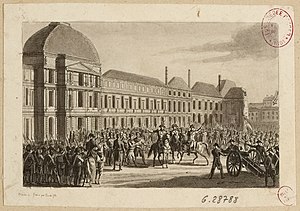
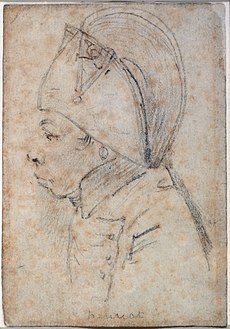
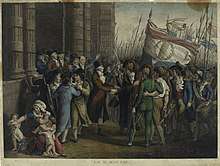
After the execution of the king, the influence of Robespierre, Danton and the pragmatic politicians increased at the expense of the Girondins who were largely seen as responsible for the inadequate response to the Flanders Campaign they had themselves initiated. At the end of February, more than a thousand shops were plundered in Paris. Protesters claimed that the Girondins were responsible for the high prices.[205] On 24 February the Convention decreed the first, but unsuccessful Levée en Masse as the attempt to draft new troops set off an uprising in rural France. The Montagnards lost influence in Marseille, Toulon and Lyon. On 10 March 1793, a provisional Revolutionary Tribunal was established; the Convention appointed Fouquier-Tinville as the public prosecutor and Fleuriot-Lescot as his assistant.
On 12 March Charles-François Dumouriez criticized the interference of officials of the War Ministry which employed many Jacobins.[206] The Jacobin leaders were quite sure that, after the Battle of Neerwinden (1793), France had come close to a military coup mounted by Dumouriez and supported by the Girondins. On 18 March Barère proposed to establish a Committee of Public Safety. On 22 March Dumouriez urged the Duke of Chartres to join his plan to dissolve the convention, to restore the French Constitution of 1791, the restoration of a constitutional monarchy and to free Marie-Antoinette and her children.[207][208] On 25 March Robespierre became one of the 25 members of the Committee of General Defence to coordinate the war effort.[209] He demanded that relatives of the king should leave France, but Marie-Antoinette should be judged.[210] He left the committee after eight days, not willing to cooperate with Girondins.
On 3 April Robespierre declared before the Convention that the whole war was a prepared game between Dumouriez and Brissot to overthrow the Republic. On 5 April the Convention substantially expanded the power of the Tribunal révolutionnaire; the Montagne raised the stakes by sending out a circular from the Jacobin Club in Paris to all the sister Jacobin clubs across France, appealing for petitions demanding the recall – that is, the expulsion from the Convention – of any deputés who had tried to save the life of ‘the tyrant’. On 6 April the Committee of Public Safety was installed with deputies from the Plaine and the Dantonists but no Girondins or Robespierrists.[211] Robespierre who was not elected was pessimistic about the prospects of parliamentary action and told the Jacobins that it was necessary to raise an army of Sans-culottes to defend Paris and arrest infidel deputies, naming and accusing the Duke of Orleans, Brissot, Vergniaud, Guadet and Gensonné.[212] There are only two parties according to Robespierre: the people and its enemies.[213] Robespierre's speeches during April 1793 reflect the growing radicalization. "I ask the sections to raise an army large enough to form the kernel of a Revolutionary Army that will draw all the sans-culottes from the departments to exterminate the rebels ..."[214] "Force the government to arm the people, who in vain demanded arms for two years."[215] Suspecting further treason, Robespierre on 13 April invited the convention to vote the death penalty against anyone who would propose negotiating with the enemy.[216] On 15 April the convention was stormed by the people of from the sections, demanding the removal of the Girondins. Till 17 April the Convention discussed the Declaration of the Rights of the Man and of the Citizen of 1793, a French political document that preceded that country's first republican constitution. On 19 April Robespierre opposed article 7 on equality before the law; on 22 April the Convention discussed article 29 on the right of resistance.[217] On 24 April 1793 Robespierre presented his version with four articles on the right of property. Robespierre was in effect questioning the individual right of ownership.[218] He advocated a progressive tax and fraternity between the people of all the nations.[219] On 27 April the Convention decreed (on proposal of Danton) to sent 20,000 additional forces to the departments in revolt.[220] Pétion called for the help of supporters of law and order.[221]
On 1 May, according to the Girondin deputé Dulaure 8,000 armed men prepared to go to the Vendée surrounded the convention and threatened not to leave if the emergency measures (a decent salary and maximum on food prices) demanded were not adopted.[222][223] Robespierre pressed ahead with his strategy of class war.[224] On 8 and 12 May in the Jacobin club, Robespierre restated the necessity of founding a revolutionary army to be funded by a tax on the rich and would be intended to defeat aristocrats and counter-revolutionaries inside both the Convention and across France. He said that public squares should be used to produce arms and pikes.[225] After hearing these statements, the Girondins became concerned. On 18 May Guadet called for the closing of all the political institutions in Paris and to examine the "exactions" and to replace municipal authorities.[226][227][228] got no support, the Convention decided instead to set up a commission of inquiry of twelve members, with a very strong Girondin majority.[229] Hébert, the editor of Le Père Duchesne, was arrested for attacking its members. The next day, the Commune demanded that Hébert be released. Maximin Isnard, who had enough of the tyranny of the municipality, then threatened with the destruction of Paris. On 24 May the Twelve proposed reinforcing the National Guard patrols round the convention.[230]
On 26 May, after a week of silence, Robespierre delivered one of the most decisive speeches of his career.[231] He openly called at the Jacobin Club "to place themselves in insurrection against corrupt deputies".[232] Isnard declared that the convention would not be influenced by any violence and that Paris had to respect the representatives from elsewhere in France.[233] The Convention decided Robespierre would not be heard and Isnard hindered him to speak. The atmosphere became extremely agitated; some deputies were willing to kill if Isnard dared to declare civil war. On 28 May the Commune accepted the creation of a sans-culottes army to protect the revolution and enforce revolutionary laws.[232] Robespierre called for an armed insurrection against the majority of the convention. On 29 May, the delegates representing 33 of the Paris sections formed an insurrectionary committee.[234] On 30 May several new members were added to the Committee of Public Safety: Saint-Just, Couthon and Hérault-Seychelles.[235] Early in the morning of Friday 31 May the city gates were closed and the tocsin in the Notre-Dame was rung. Hanriot ordered to fire a canon on the Pont-Neuf as a sign of alarm. Vergniaud suggested to arrest Hanriot. Robespierre attacked Vergniaud and accused the Girondins of royalism.[236] He urged the arrest of the Girondins, who had supported the installation of the Commission of Twelve. Around ten in the morning 12,000 armed citizens appeared to protect the Convention against the arrest of Girondin deputies. In the afternoon the Commune demanded the creation of a Revolutionary army of sansculottes in every town of France, including 20,000 men in Paris.[237] On the night of June 1 the Comité insurrectionnel ordered the arrest of Roland and Clavière. ordered François Hanriot, to surround the Convention ‘with a respectable armed force’.[238] On Saturday afternoon 40,000 men surrounded the convention to force the arrest. The attack on the representatives was led by Marat. He called for the arrest of nine members of the Commission of Twelve and repeated his call for the expulsion of 22 Girondins, who in January had voted against the execution of the King and since then paralyzing the convention.[239][240] The accused Girondins believed they were protected by the law, but the people on the galleries called for their arrest.
The commune declaring itself duped demanded and prepared a "Supplement" to the revolution. The next day Hanriot was ordered to march his National Guard from the town hall to the National Palace.[241] In the early evening on 2 June, a large force of armed citizens, some estimated 80,000, but Danton spoke of 30,000 souls,[242] surrounded the convention with artillery. "The armed force", Hanriot said, "will retire only when the Convention has delivered to the people the deputies denounced by the Commune."[243] The accused Girondins attempted to exit, walked around the palace in a theatrical procession and confronted on all sides by bayonets and pikes, returned to the meeting hall and submitted to the inevitable. Twenty-two Girondins were seized one by one after some juggling with names.[244] They finally decided that 31 deputies were not to be imprisoned,[lower-alpha 13] but only subject to house arrest.[245]
The Montagnards now had unchallenged control of the convention; according to Couthon the citizens of Paris had saved the country.[246] The Girondins, going to the provinces, joined the counter-revolution.[247] Within two weeks and for three months almost fifty departments were in rebellion.
During the insurrection of 31 May – 2 June 1793 Robespierre had scrawled a note in his memorandum-book:
What we need is a single will (il faut une volonté une). It must be either republican or royalist. If it is to be republican, we must have republican ministers, republican newspapers, republican deputies, a republican government. The internal dangers come from the middle classes; to defeat the middle classes we must rally the people. ... The people must ally itself with the Convention, and the Convention must make use of the people.[248][249]
On 13 July Robespierre defended the plans of Le Peletier to teach revolutionary ideas in schools.[250] On the following day the Convention rushed to praise Marat for his fervor and revolutionary diligence. Opposing Pierre-Louis Bentabole Robespierre simply called for an inquiry into the circumstances of his death.
Reign of Terror
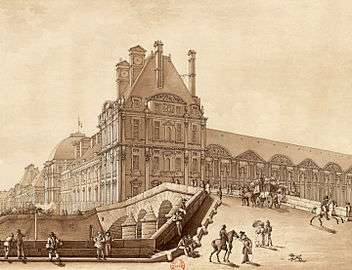
After the fall of the Girondins, the French government faced serious internal challenges, when four provincial cities—Caen, Bordeaux, Lyon, and Marseille—rebelled against the more radical revolutionaries in Paris. In July France threatened to plunge into civil war, attacked by the aristocracy in Vendée and Brittany, by federalism in Lyon, in Le Midi and in Normandy, in a struggle with all Europe and the foreign factions.[251]
On 27 July 1793, Robespierre was added to the Committee of Public Safety and replaced Gasparin the only member of a sleeping subcommittee of war.[252] It was the second time he held any executive office to coordinate the war effort. It may seem Robespierre behaved as a kind of Minister without Portfolio,[253] apparently as the unofficial prime-minister but the committee was non-hierarchical.[254]
On 4 August the French Constitution of 1793 which included universal suffrage passed through the convention. Article 109 stated: All Frenchmen are soldiers; all shall be exercised in the use of arms.[255] From the moment of its acceptance, it was made meaningless, first by the Convention itself, which had been charged to dissolve itself on completion of the document, then by the construction of the working institutions of the Terror.[256][lower-alpha 14] On 21 August Robespierre was elected as president of the convention.[260] He was particularly concerned that the public officials should be virtuous.[261] He sent his brother Augustin (and sister Charlotte) to Marseille and Nice to suppress the federalist insurrection.[262]
On 4 September, the Sans-culottes again invaded the convention. They demanded tougher measures against rising prices and the setting up of a system of terror to root out the counter-revolution.[263] On 5 September the Convention decided on a proposal of Chaumette, supported by Billaud and Danton to form a revolutionary army of 6,000 men in Paris to sweep away conspirators, to execute revolutionary laws and to protect subsistence.[264][lower-alpha 15] The next day the ultra's Collot d'Herbois and Billaud-Varenne were elected in the Committee of Public Safety.[267] The Committee of General Security which was tasked with rooting out crimes and preventing counter-revolution began to manage the country's National Gendarmerie and finance. On 8 September, the banks and exchange offices were closed to prevent the exchange of forged assignats and the export of capital.[268] On 11 September the power of the Comité de Salut Public was extended for one month. On 17 September, the Law of Suspects was passed, which authorized the imprisonment of vaguely defined "suspects" within 24 hours. Jacques Thuriot, a firm supporter of Danton, resigned on 20 September because of irreconcilable differences with Robespierre and became one of the bolder opponents of Maximilien Robespierre.[269] The Revolutionary Tribunal was reorganized and divided into four sections, of which two were always active at the same time. On 29 September, the Committee introduced the General maximum, particularly in the area which supplied Paris.[270] On 1 October the Convention decided to exterminate the "brigands" in the Vendée before the end of the month.
On 3 October Robespierre was convinced the convention was divided up in two factions, friends of the people and conspirators.[271] He defended 73 Girondins as useful,[272][273] in order to serve as hostages,[274] but more than 20 were sent on trial. He attacked Danton, who had refused to take a seat in the Comité, and believed a stable government was needed which could resist the orders of the Comité de Salut Public.[275] On 8 October the Convention decided to arrest Brissot and the Girondins. Robespierre called for the dissolution of the convention; he believed they would be admired by posterity. The president Cambon replied that was not his intention; applause followed and the session was closed.[276] After the Siege of Lyon Couthon entered the city, the centre of a revolt. On 10 October the Convention decreed to recognize the Committee of Public Safety as the supreme "Revolutionary Government",[277] (which was consolidated on 4 December).[278] The provisional government would be revolutionary until peace according to Saint-Just. Every eight days the Committee of Public Safety would report to the convention.[279] Though the Constitution was overwhelmingly popular and its drafting and ratification buoyed popular support for the Montagnards, on 10 October the Convention set it aside indefinitely until a future peace.[280] They would instead continue governing without a Constitution.[281] The Committee became a War Cabinet with unprecedented powers over the economy as well as the political life of the nation, but it had to get the approval of the convention for any legislation and could be changed any time.[282] Danton who was dangerously ill since a few weeks,[283] probably knowing that he could not get along with Robespierre,[284] quit politics and set off to Arcis-sur-Aube with his 16-year-old wife, who pitied the Queen since her trial began.[285]
On 12 October when Hébert accused Marie-Antoinette of incest with her son, Robespierre had dinner with Barère, Saint-Just and Joachim Vilate. Discussing the matter, Robespierre broke his plate with his fork and called Hébert an "imbécile".[286][287][288] According to Vilate Robespierre then had already two or three bodyguards. One of them was his neighbour, the printer Nicolas. The verdict of the former queen, pronounced by the jury of the Revolutionary Tribunal, on the 16th, at four o'clock in the morning, was executed at noon.[289] On 25 October the Revolutionary government was accused of doing nothing.[290] At the end of the month, several members of the General Security Committee assisted by armées revolutionnaires were sent into the provinces to suppress active resistance against the Jacobins. Fouché and Collot d'Herbois halted the revolt of Lyon against the National Convention, Jean-Baptiste Carrier ordered the drownings at Nantes; Tallien succeeded in feeding the guillotine in Bordeaux; Barras and Fréron went to Marseille and Toulon and Joseph Le Bon in Somme and Pas-de-Calais. Saint-Just and Le Bas visited the Rhine Army to watch the generals and punish officers for the least sign of treasonous timidity, or lack of initiative.[291] On 31 October Brissot and 21 Girondins were guillotined in 36 minutes.
On the morning of 14 November, François Chabot burst into Robespierre's room dragging him from bed with accusations of counter-revolution and a foreign conspiracy, waving a hundred thousand livres in assignat notes, claiming that a band of royalist plotters gave it to him to buy Fabre d'Eglantine's vote, along with others, to liquidate some stock in the French East India Company.[292][293] Chabot was arrested three days later; Courtois urged Danton to return to Paris immediately. On 25 November, the remains of Comte de Mirabeau were removed from the Pantheon and replaced with those of Jean-Paul Marat.[294] It was on the initiative of Robespierre when it became known that in his last months the count had secretly conspired with the court of Louis XVI.[295] On 3 December Robespierre accused Danton in the Jacobin club of feigning an illness with the intention to emigrate to Switzerland. Danton showed too often his vices and not his virtue. Robespierre was stopped in his attack. The gathering was closed after applause for Danton.[296]
On 4 December, by the Law of Revolutionary Government, the independence of departmental and local authorities came to an end, when extensive powers of Committee of Public Safety were codified. This law, submitted by Billaud, implemented within 24 hours, was a drastic decision against the independence of deputies and commissionaires on a mission; coordinated action among the sections became illegal.[297] The Commune of Paris and the revolutionary committees in the sections had to obey the law, the two Committees and the convention.[298] On 7 December all the armées revolutionnaires in France were dismissed within 24 hours (except the ones authorized by the convention as in Paris).[299] On 12 December the Indulgents mounted an attack on the Committee of Public Safety being murderers.[300] Under intense emotional pressure from Lyonnaise women, protesting at the end of November and gathering 10,000 signatures Robespierre suggested that a secret commission be set up to examine the cases of the Lyon rebels, to see if injustices had been committed by Collot d'Herbois and Fouché. This is the closest he came to adopting a public position against the use of terror.[301]
The "enemy within"
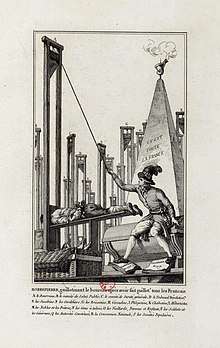
On 5 December the journalist Camille Desmoulins launched a new journal, Le Vieux Cordelier. He defended Danton and warned not to exaggerate the revolution. He compared Robespierre with Julius Caesar and arguing that the Revolution should return to its original ideas en vogue around 10 August 1792.[302] In the third issue he change tone. Robespierre made a counterproposal, to set up a Committee of Justice to examine some of the cases under the Law of Suspects.[303] In the fourth issue Desmoulins took up the cause of the 200,000 defenseless civilians and had been detained in prisons as suspects.[304] A Committee of Grace had to be established. Desmoulins addressed Robespierre directly, writing, "My dear Robespierre... my old school friend... Remember the lessons of history and philosophy: love is stronger, more lasting than fear."[305] Desmoulins counselled Robespierre not to attempt to build the Republic on such a rare quality as virtue. On the next day, December 25, thoroughly provoked by Desmoulins’ insistent challenges, Robespierre produced his Report on the Principles of Revolutionary Government. [306] Robespierre replied to the plea for an end to the Terror, justifying the collective dictatorship of the National Convention, administrative centralization, and the purging of local authorities. He said he had to avoid two cliffs: indulgence and severity. He could not consult the 18th century political authors, because they had not foreseen such a course of events. He protested against the various factions [Hébertists and Dantonists] that threatened the government.[307][308] Robespierre strongly believed that the Terror should be increased in intensity, rather than diminished; "the Government has to defend itself" [against conspirators] and "to the enemies of the people it owes only death.”[309][310][311] According to R.R. Palmer and Donald C. Hodges, this was the first important statement in modern times of a philosophy of dictatorship.[312][313]
In his Report on the Principles of Political Morality of 5 February 1794, Robespierre praised the revolutionary government and argued that terror and virtue were necessary:
If virtue is the spring of a popular government in times of peace, the spring of that government during a revolution is virtue combined with terror: virtue, without which terror is destructive; terror, without which virtue is impotent. Terror is only justice prompt, severe and inflexible; it is then an emanation of virtue; it is less a distinct principle than a natural consequence of the general principle of democracy, applied to the most pressing wants of the country ... The government in a revolution is the despotism of liberty against tyranny.[314]
Aulard sums up the Jacobin train of thought, "All politics, according to Robespierre, must tend to establish the reign of virtue and confound vice. He reasoned thus: those who are virtuous are right; error is a corruption of the heart; error cannot be sincere; error is always deliberate."[315][316] From 13 February to 13 March 1794, Robespierre had withdrawn from active business on the Committee due to illness.[317] (On 19 February, Maximilien decided therefore to return to the Duplays.[318]) In a speech at the Cordeliers Club, Hébert attacks both the factions of Danton and Robespierre. On 15 March, he reappeared in the convention.[lower-alpha 16] Subsequently, he joined Saint-Just in his attacks on Hébert.[22] Hébert, the voice of the Sans-culottes, had been using the latest issue of Le Père Duchesne to criticize Robespierre. (There were queues and near-riots at the shops and in the markets; there were strikes and threatening public demonstrations; and some of the Hébertistes and their friends were calling for a new insurrection.[320]) On the night of 13–14 March, Hébert and 18 of his followers were arrested on charges of complicity with foreign powers and guillotined on 24 March. The leaders of the "armées révolutionnaires" were denounced by the Revolutionary Tribunal as accomplices of Hébert.[321][lower-alpha 17] Their death was a sort of carnival, a pleasant spectacle according to Michelet's witnesses.
On 25 March Condorcet was arrested as he was seen as an enemy of the Revolution; he committed suicide two days later. On 29 March Danton met again with Robespierre privately; afterwards, Marat's sister urged him to take the offensive.[326] On 30 March the two committees decided to arrest Danton and Desmoulins after Saint-Just became uncharacteristically angry.[327] On 31 March Saint-Just publicly attacked both. In the Convention criticism was voiced against the arrests, which Robespierre silenced with "...whoever trembles at this moment is guilty."[328] Legendre suggested to hear Danton in the convention but Robespierre replied "It would be violating the laws of impartiality to grant to Danton what was refused to others, who had an equal right to make the same demand. This answer silenced at once all solicitations in his favour."[329] No friend of the Dantonists dared speak up in case he too should be accused of putting friendship before virtue.[330]
On 2 April the trial began on charges of conspiracy with the Duke of Orléans and Dumouriez. Corruption and a financial scandal involving the French East India Company provided a "convenient pretext" for Danton's downfall.[331][332] The Dantonists were not serving the people. They had become false patriots, who had preferred personal and foreign interests to the welfare of the nation. "Danton had been a traitor from the beginning of the Revolution and the emergency law voted to stifle his resounding voice make this one of the blackest moments in the whole history of the Revolution."[333][334] The defendants, of whom nine were députés of the Convention, were removed from the room before the verdict was delivered. Fouquier-Tinville asked the tribunal to order the defendants who “confused the hearing” and insulted “National Justice” to the guillotine. Desmoulins struggled to accept his fate and accused Robespierre, the Committee of General Security and the Revolutionary Tribunal. He was dragged up the scaffold by force. On the last day of their trial Lucile Desmoulins was imprisoned. She was accused of organizing a revolt against the patriots and the tribunal to free her husband and Danton. She admitted to having warned the prisoners of a course of events as in September 1792, and that it was her duty to revolt against it. Remarkably Robespierre was not only their eldest friend but also witnessed at their marriage in December 1790, together with Pétion and Brissot.[335][336]
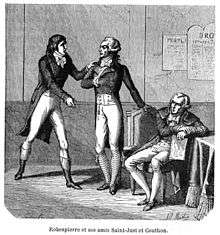
On 1 April Lazare Carnot proposed the provisional executive council of six ministers be suppressed and the ministries be replaced by twelve Committees reporting to the Committee of Public Safety.[219] The proposal was unanimously adopted by the National Convention and set up by Martial Herman on 8 April. When Barras and Fréron paid a visit to Robespierre, they were received extremely unfriendly. (Robespierre was without the spectacles he usually wore in public.) At the request of Robespierre, the Convention orders the transfer of the ashes of Jean-Jacques Rousseau to the Panthéon. On 16 April, it was decreed to bring all the political suspects in France to the Revolutionary Tribunal to Paris; the two committees received the power to interrogate them immediately. Foreigners were no longer allowed to travel through France or visit a Jacobin club. On 22 April three politicians were taken to the scaffold: Malesherbes and the deputés Isaac René Guy le Chapelier and Jacques Guillaume Thouret, four times elected president of the Constituent Assembly. On 23 April a General Police Bureau was set up, independent of the Committee of General Security, tasked with gathering information and mostly report directly to Robespierre.[337][338] Robespierre took over the running and expanded its remit within a week when Saint-Just left Paris for the army in the north.[339]
On 5 June François Hanriot ordered to detain every baker in Paris who sold his bread to people without (distribution) card or from another section.[340] On 10 June Georges Couthon introduced the drastic Law of 22 Prairial. The Tribunal became a simple court of condemnation refusing suspects the right of counsel and allowing only one of two verdicts – complete acquittal or death and that based not on evidence but on the moral conviction of the jurors.[341][342] The courtroom was renovated to allow sixty people to be sentenced simultaneously. The guillotine was moved to the Faubourg Saint-Antoine in order to stand out less. On 11 July the shopkeepers, craftsmen, etc. were temporarily released from prison. According to François Furet, the prisons were overpopulated; they housed over 8,000 "suspects" at the beginning of Thermidor year II.[343] Within three days, 156 people were sent in batches to the guillotine; all the members of Parliament of Toulouse were executed.[344][345] The city also had to solve serious problems on the cemeteries because of the smell. Mid-July two new mass graves were dug at Picpus Cemetery in the impermeable ground.[346][347]
Abolition of slavery
Throughout the Revolution, Robespierre (at times ambivalently and at others outspokenly) opposed slavery on French soil or in French territories and he played an important role in abolishing it.[348][349]
On 12 May the National Assembly gave citizenship to mulattos, but the colonial whites refused to implement the decree.[350] Robespierre argued passionately in the National Assembly against the Colonial Committee, dominated by slaveholders in the Caribbean. The colonial lobby declared that political rights for Black people would cause France to lose her colonies. Robespierre responded, "We should not compromise the interests humanity holds most dear, the sacred rights of a significant number of our fellow citizens," later shouting, "Death to the colonies!"[351] Robespierre was furious that the assembly gave "constitutional sanction to slavery in the colonies," and argued for equal political rights regardless of skin colour.[352] Robespierre did not argue for slavery's immediate abolition, but slavery advocates in France regarded Robespierre as a "bloodthirsty innovator" and a traitor plotting to give French colonies to England.[351] Only months later, hundreds of thousands of slaves in St Domingue led a revolution against slavery and colonial rule.[353]
In the following years, the slaves of St. Domingue effectively liberated themselves and formed an army to oppose re-enslavement. Robespierre denounced the slave trade in a speech before the Convention in April 1793.[354] The radical 1793 constitution supported by Robespierre and the Montagnards, which was ratified by a national referendum, granted universal suffrage to French men and explicitly condemned slavery. However, the constitution was never implemented.[354] In November 1793, Robespierre supported a proposal to investigate the colonial general Léger-Félicité Sonthonax, a Girondist who had freed slaves in the colonies.[354] At the same time, Robespierre denounced the French minister to the newly formed United States, Edmond-Charles Genêt, who had sided with Sonthonax.[354]
By 1794, French debates concerning slavery reached their apogee. In late January, delegations representing both former slaveholders as well as former slaves arrived in France to petition respectively for the abolition of slavery and its abolition.[354] After being briefly imprisoned, the delegation opposing slavery was freed on the orders of the Committee of Public Safety, on which Robespierre sat. Receiving the delegation on their release, the National Convention passed a decree banning slavery on 4 February.[354] At the same time, Robespierre and the Committee of Public Safety heard a petition from the slaveholders but did not adopt it. On the day after the emancipation decree, Robespierre delivered a speech to the National Convention in which he praised the French as the first to "summon all men to equality and liberty, and their full rights as citizens," using the word slavery twice but without specifically mentioning the French colonies.[354] Despite petitions from the slaveholding delegation, Robespierre and the Committee decided to endorse the decree in full.[354]
Several weeks later, in a speech before the Committee of Public Safety, Robespierre linked the cruelty of slavery with serfdom:
Ask a merchant of human flesh what is property; he will answer by showing you that long coffin he calls a ship... Ask a gentleman [the same] who has lands and vassals... and he will give you almost the identical ideas.
He attended a meeting of the Jacobin club in June 1794 to support a decree ending slavery, and later signed orders to ratify it.[355] The decree led to a surge in popularity for the Republic among Black people in St-Domingue, most of whom had already freed themselves and were seeking military alliances to guarantee their freedom.[352]
Cult of the Supreme Being
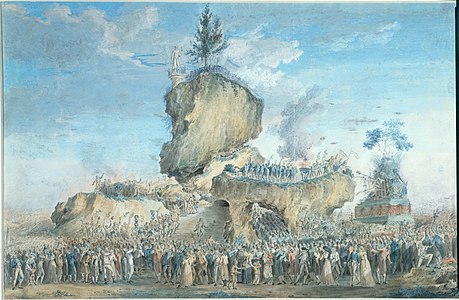
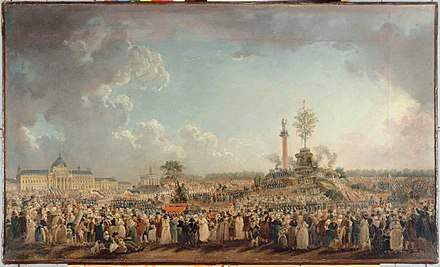
Robespierre's desire for revolutionary change was not limited only to the political realm. He also opposed the Catholic Church and the pope, particularly their policy of clerical celibacy.[357] Having denounced the Cult of Reason and other perceived excesses of dechristianization undertaken by political opponents in France, he sought to instil a spiritual resurgence across the nation predicated on Deist beliefs. On 6 May 1794 Robespierre announced to the Convention that in the name of the French people, the Committee of Public Safety had decided to recognize the existence of God and the immortality of the human soul. Accordingly, on 7 May, Robespierre delivered a long presentation to the Convention ‘on the relation of religious and moral ideas to republican principles, and on national festivals’.[219] Robespierre supported a decree that the Convention passed to establish an official state religion called the Cult of the Supreme Being. The notion of the Supreme Being was based on the creed of the Savoy chaplain that Jean-Jacques Rousseau had outlined in Book IV of Emile.
In the afternoon of 8 June (also the Christian holiday of Pentecost) a "Festival of the Supreme Being" was held. Everything was arranged to the exact specifications that had been drawn up previously set before the ceremony. The ominous and symbolic guillotine had been moved to the original standing place of the Bastille. Pregnant women and breastfeeding mothers with their babies were specifically invited to walk in the procession which started at the Tuileries.[358] (Joachim Vilate had invited Robespierre to have lunch in the Pavillon de Flore, but he ate little.)
The festival was also Robespierre's first appearance in the public eye as a leader for the people, and also as president of the convention, to which he had been elected only four days earlier.[359] Witnesses state that throughout the "Festival of the Supreme Being", Robespierre beamed with joy. He was able to speak of the things about which he was truly passionate, including virtue, nature, deist beliefs and his disagreements with atheism. He dressed elaborately, wearing feathers on his hat and holding fruit and flowers in his hands, and walked first in the festival procession. According to Michelet: "Robespierre, as usual, walked quickly, with an agitated air. The Convention did not move nearly so fast. The leaders, perhaps maliciously and out of perfidious deference, remained well behind him, thereby isolating him."[360] The procession ended on the Champ de Mars. The Convention climbed to the summit, where a liberty tree had been planted.[219] (The choirs were composed by Étienne-Nicolas Méhul and François-Joseph Gossec, with lyrics from the obscure poet Théodore Désorgues.) Robespierre delivered two speeches in which he emphasized his concept of a Supreme Being:
Is it not He whose immortal hand, engraving on the heart of man the code of justice and equality, has written there the death sentence of tyrants? Is it not He who, from the beginning of time, decreed for all the ages and for all peoples liberty, good faith, and justice? He did not create kings to devour the human race. He did not create priests to harness us, like vile animals, to the chariots of kings and to give to the world examples of baseness, pride, perfidy, avarice, debauchery and falsehood. He created the universe to proclaim His power. He created men to help each other, to love each other mutually, and to attain to happiness by the way of virtue.[361]
Robespierre came down the mountain in a way that resembled Moses as the leader of the people. To offset his small stature (5’3" = 160 cm), he wore elevated shoes with silver buckles. While for some it was exciting to see him at his finest, other deputies agreed that Robespierre had played too prominent a role. Someone was heard saying, "Look at the blackguard; it's not enough for him to be master, he has to be God". On 15 June, the president of the Committee of General Security Vadier on behalf of the two committees presented a report on a new conspiracy by Catherine Théot, Christophe Antoine Gerle and three others. He insinuated that Robespierre fitted her prophecies.[362] His speech caused much laughter in the convention. Robespierre felt ridiculed and demanded on the 26th that the investigation of Théot be stopped and Fouquier-Tinville replaced.[363] Robespierre with his ‘tyrannical habit of judging’ demanded the heads of nine people, who opposed his republic of virtue.[364] According to Madame de Staël, it was from that time he was lost.[365]
Downfall
_%E2%80%93_Destailleur_Paris_tome_6%2C_1292_%E2%80%93_Gallica_2013_(adjusted).jpg)
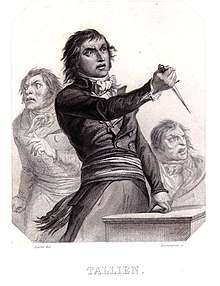

On 20 May, Robespierre personally signed the warrant for Theresa Cabarrus' arrest. Never did Robespierre pursue a victim more remorselessly.[366] On 23 May, Cécile Renault was arrested after having approached Robespierre's residence with two penknives and a change of underwear in her bag. She said the fresh linen was for her execution.[367] Dressed in a red smock she was executed together with her parents (and 52 others) one week later. Robespierre refused to reunite husbands, wives and children dispersed in different prisons in a common detention house.[368] He used this assassination attempt against him as a pretext for scapegoating the British.[369]
On 10 June, the Law of 22 Prairial was introduced without consultation from the Committee of General Security, which deepened the conflict between the two committees.[370] It doubled the number of executions; the so-called "Great Terror" had begun. Collot d'Herbois, Fouché and Tallien feared for their lives, due to the excesses carried out by them in various regions of France to stamp out opposition to the revolutionary government.[371] Almost all the deputies agreed it had become dangerous.
On 11 June Robespierre attacked Fouché, accusing him of leading a conspiracy. On 24 June Carnot foresightedly despatched a large part of the Parisian artillery to the front.[372] At the end of June, Saint-Just arrived in Paris and discovered that Robespierre's political position had degraded significantly. Carnot and Cambon proposed to end the terror. Carnot described Saint-Just and Robespierre as "ridiculous dictators".[219][373] On 1 July, Robespierre spoke in the Jacobin club: "In London, I am denounced to the French army as a dictator; the same slanders have been repeated in Paris."[219] On 3 July he left the Committee slamming the door and shouting "Then save the country without me".[374] He attacked Tallien and had him excluded from the Jacobins on 11 July.[375] On 14 July Robespierre had Fouché expelled. To evade arrest, which usually took place during the night, about fifty deputies avoided staying at home. On 22 and 23 July, the two committees met in a plenary session. Both committees were responsible for suppressing counterrevolution but ended targeting each other.[277][376] Saint-Just declared in negotiations with Barère that he was prepared to make concessions on the subordinate position of the Committee of General Security.[377][378] Couthon agreed to more cooperation between the two committees. For Robespierre, the Committee of General Security had to remain subordinate to the Committee of Public Safety. He wanted to take away the authority of the Committee of General Security.[379]
From 23 July almost all the workers in Paris were on strike.[380] Within a few days Robespierre decided to make himself clear in a new report. On Saturday 26 July, Robespierre reappeared at the convention and delivered a two-hour-long speech on the villainous factions.[381] Dressed in the same sky-blue coat and nankeen trousers which he had worn on the proclamation of the Supreme Being, he defended himself against charges of dictatorship and tyranny and then proceeded to warn of a conspiracy against the Committee of Public Safety. Calumny, he charged, had forced him to retire for a time from the Committee of Public Safety; he found himself the most unhappy of men. He gave the impression that no one was his friend, that no one could be trusted.[382] He complained of being blamed for everything;[383] and that not only England but also members of the Committee of General Security were involved in intrigue to bring him down. (When he was interrupted Robespierre accused the Convention of limiting the freedom of speech; Billaud Varennes replied they all wanted that.[384]) Specifically, he railed against the bloody excesses he had observed during the Terror.[385] "I'm made to fight crime, not to govern it ", he exclaimed.[386] Intoxicated with his virtue, Robespierre announced a new wave of purification. "Punish the traitors, purge the bureau of the Committee of General Security, purge the Committee itself, and subordinate it to the Committee of Public Safety, purge the Committee of Public Safety itself and create a unified government under the supreme authority of the Convention".[387]
When called upon to name those whom he accused, he simply refused. Joseph Cambon flew to the rostrum. "One man paralyzes the will of the National Convention".[388] His vehemence changed the course of the debate.[389] The Convention decided not to have the text printed, as Robespierre's speech had first to be submitted to the two committees. It contained matters sufficiently weighty that it needed to first be examined.[390] Robespierre was surprised that his speech would be sent to the very deputies he had intended to sue.
In the evening, Robespierre delivered the same speech, which he regarded as his last will, at the Jacobin Club, where it was very well received.[391] He spoke of drinking hemlock, and David, the painter, cried out: ‘I will drink it with you.’ Collot d'Herbois and Billaud-Varenne were driven out because of their opposition to the printing and distribution of the text. Billaud managed to escape before he was assaulted, but Collot d'Herbois was knocked down. They set off to the Committee of Public Safety, where they found Saint-Just working. They asked him if he was drawing up their bill of indictment. Saint-Just promised to show them his speech before the session began.[392][393]
Gathering in secret, nine members of the two committees decided that it was all or nothing; after exactly one year in power Robespierre had to be voted off. Barras said they would all die if Robespierre did not. (The Convention lost 144 delegates in 13 months; 67 were executed, committed suicide, or died in prison.) Now extremists and indulgents joined against him. Laurent Lecointre was the instigator of the coup,[394] assisted by Barère, Fréron, Barras, Tallien, Thuriot, Courtois, Rovère, Garnier de l’Aube and Guffroy. (Fouché was no longer involved and had hidden.[395]) Each one of them prepared his part in the attack. They decided that Hanriot, his aides-de-camp, Lavalette and Boulanger,[396] the public prosecutor Dumas, the family Duplay and the printer Charles-Léopold Nicolas had to be arrested first, so Robespierre would be without support.[394]
At noon, Saint-Just went straight to the convention, prepared to blame everything on Billaud, Collot d'Herbois and Carnot.[397] He began: "I am from no faction; I will contend against them all."[321] [385] After a few minutes, Tallien — having a double reason for desiring Robespierre's end, as, on the evening before, Robespierre refused to release Theresa Cabarrus — interrupted him and began the attack. "Yesterday a member of the government was left quite isolated and made a speech in his own name; today another one has done the same thing." He continued "Yesterday, the president of the revolutionary tribunal [Dumas] openly proposed to the Jacobins that they should drive all impure men from the Convention." Billaud-Varennes complained about how he was treated in the Jacobin club on the evening before and that Saint-Just had not kept his promise the show his speech before the meeting. Since March they had organized a spy system among the representatives in the Convention whom they wanted to destroy. He better stop talking about justice and virtue. Billaud would use his dagger if Robespierre was not arrested.[398] Tallien demanded the arrest of Dumas, Hanriot and Boulanger. According to Barère, the committees asked themselves why there still existed a military regime in Paris; why all these permanent commanders, with staffs, and immense armed forces? The committees have thought it best to restore to the National Guard its democratic organization.[399]
As the accusations began to pile up, Saint-Just remained silent. Robespierre rushed toward the rostrum, appealed to the Plain to defend him against the Montagnards, but his voice was shouted down. Robespierre rushed to the benches of the Left but someone cried: "Get away from here; Condorcet used to sit here". He soon found himself at a loss for words after Vadier gave a mocking impression of him referring to the discovery of a letter under the mattress of the illiterate Catherine Théot.[lower-alpha 18] When Garnier witnessed Robespierre's inability to respond, he shouted, "The blood of Danton chokes him!"[404] Robespierre then finally regained his voice to reply with his one recorded statement of the morning, a demand to know why he was now being blamed for the other man's death: "Is it Danton you regret? ... Cowards! Why didn't you defend him?"[405]
Arrest
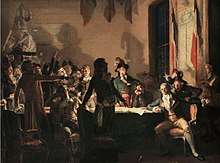
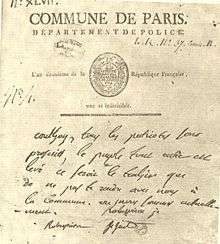
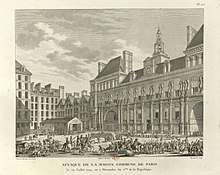
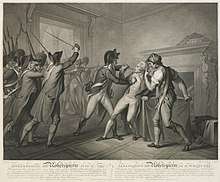
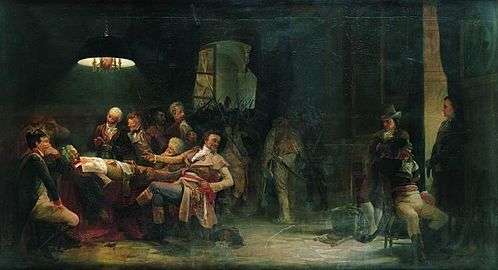
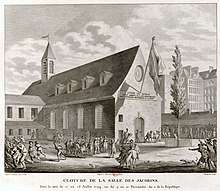
At around 1 or 2 p.m., Louis Louchet called for Robespierre's arrest; Robespierre the Younger demanded to share his fate. The whole Convention agreed including the two other members of the triumvirate, Couthon and Saint-Just. Le Bas decided to join Saint-Just. Robespierre shouted that the revolution was lost when he descended the tribune. The five deputies were taken to the Committee of General Security and questioned. At around 3 p.m. Hanriot was ordered to appear in the convention; he or someone else suggested to only show up accompanied by a crowd. (Dumas was already arrested at noon and at four taken to Sainte-Pélagie Prison, as well as members of the family Duplay.[407]) On horseback, Hanriot warned the sections that there would be an attempt to murder Robespierre and mobilized 2,400 National Guards in front of the town hall.[219][408][409][410] What had happened was not very clear to their officers; either the convention was closed down or the Paris Commune. Nobody explained anything.[411] The Paris Commune ordered to close the gates (and to ring the tocsin) and summoned an immediate meeting of the sections to consider the dangers threatening the fatherland.[412] For the Convention that was an illegal action without permission of the two committees. It was decreed that anyone leading an "armed force" against the convention would be regarded as an outlaw.
At around 7 p.m. the five deputies were taken in a cab to different prisons. Robespierre to the Palais du Luxembourg, Couthon to "La Bourbe" and Saint-Just to the "Écossais". Augustin was taken from Prison Saint-Lazare to La Force Prison,[413] like Le Bas who was refused at the Conciergerie.[414][415][109] The Paris Commune was in league with the Jacobins to bring off an insurrection, asking them to send over reinforcements from the galleries, ‘even the women who are regulars there’.[191] At some time Hanriot appeared at the Place du Carrousel in front of the Convention but he was taken prisoner. According to Eric Hazan: "Now came the turning-point of this journée: instead of taking advantage of its superiority, in both guns and men, to invade the nearby hall where the Convention was sitting, the column, lacking orders or leaders, returned to the Maison-Commune."[219] After 9 p.m. the vice-president of the Tribunal Coffinhal went to Committee of General Security with 3,000 men and their artillery.[416] As Robespierre and his allies had been taken to a prison in the meantime he succeeded only in freeing Hanriot and his adjutants.[417][418]
How the five deputies escaped from prison was disputed. According to Le Moniteur Universel the jailers refused to follow the order of arrest, taken by the convention.[419] According to Courtois,[414] and Fouquier-Tinville the police administration was responsible for any in custody or release.[420] Nothing could be done without an order of the mayor.[421] Escorted by two municipals Robespierre the younger was the first to arrive at the town hall.[422][423] An administrator of the police, who happened to be at the Luxembourg palace took Robespierre the older around 8 p.m. to the police administration on Île de la Cité; Robespierre insisted being received in a prison.[424] He hesitated for legal reasons for possibly two hours.
At around 10 p.m. the mayor appointed a delegation to go and convince Robespierre to join the Commune movement.[219] Robespierre was taken to the town hall.[425][426] At around 11 p.m. Saint-Just was delivered,[427] after which Le Bas and Dumas were brought in.[414] (Couthon arrived as the last one in the town hall, but after midnight.[428][429]) The Convention declared the five deputies (plus the supporting members) to be outlaws. It then appointed Barras and ordered troops (4,000 men) to be called out.[430]
After a whole evening spent waiting in vain for action by the Commune, losing time in fruitless deliberation, without supplies or instructions, the armed sections began to disperse. According to Colin Jones apathy prevailed with most of them drifting back to their homes.[423] Around 400 men from three sections seem to have stayed on the Place de Grève according to Courtois, whose report has a poor reputation.[431][432] At around 2 a.m. Barras and Bourdon accompanied by several members of the Convention arrived in two columns. Barras deliberately advanced slowly, in the hope of avoiding conflict by a display of force.[432][430] Then Grenadiers burst into the Hôtel de Ville; 51 insurgents were gathering on the first floor. Robespierre and his allies had withdrawn in the smaller "secrétariat".[433]
There are many stories what happened then. Le Bas killed himself with a pistol, handing another to Robespierre, who shot himself in the jaw.[434] According to Barras and Courtois Robespierre tried to commit suicide,[435][436][437] pointed at his mouth but didn't succeed as a gendarme seem to have prevented this.[438] (This change in orientation might explain how Robespierre, sitting in a chair, got wounded from the upper right in the lower left jaw.[439][440][415][lower-alpha 19]) According to Bourdon the soldier Méda wounded Robespierre from a short distance and then succeeded hitting Couthon's helper in his leg.[442][443][444][445][446] Couthon was found lying at the bottom of a staircase in a corner, having fallen from the back of his gendarme. In order to avoid capture, Augustin Robespierre took off his shoes and jumped from a broad cornice.[447] He landed on some bayonets resulting in a pelvic fracture and several serious head contusions, in an alarming state of "weakness and anxiety".[448] The unperturbed Saint-Just gave himself up without a word. According to Méda Hanriot tried to escape by a concealed staircase to the third floor.[449] Most sources say that Hanriot was thrown out of a window by Coffinhal after being accused of the disaster. (According to Ernest Hamel it is one of the many legends spread by Barère.[450]) Anyhow, Hanriot landed in a small courtyard on a heap of glass.[411] He had strength enough to crawl into a drain where he was found twelve hours later and taken to the Conciergerie.[411] Coffinhal who succeeded escaping was arrested seven days later, totally exhausted.[451][452]
Execution
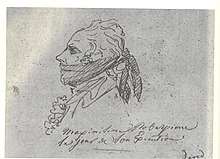
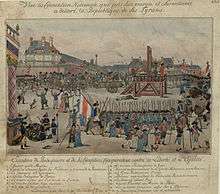
For the remainder of the night, Robespierre was laid in an antechamber of the Committee of General Security.[453] He lay on the table with his head on a deal (pine) box, bleeding profusely. At 5 a.m. his brother and Couthon seem to have been taken to the nearest hospital, Hôtel-Dieu de Paris, to see a doctor. Barras denied that Robespierre was sent there too; the circumstances did not permit it.[454] A military doctor was invited and removed some of his teeth and fragments of his broken jaw. Robespierre was then placed in the cell in the Conciergerie and deposited on the bed in which Danton had slept while detained.[411]
In the afternoon of 10 Thermidor (28 July, a décadi, a day of rest and festivity) the Revolutionary Tribunal condemned Robespierre and 21 "Robespierrists" (c.q. 13 members of the insurrectionary Commune) to death by the rules of the law of 22 Prairial, only verifying their identity at the trial. Halfway through the proceedings, Fouquier-Tinville, who did not want to pass judgment on his friend the mayor Fleuriot-Lescot, took off his official robe.[455] In the late afternoon, the convicts, whose average age was 34 years old, were taken in three carts to the Place de la Révolution to be executed along with the cobbler Antoine Simon, the jailer of the Dauphin. A mob screaming curses followed them right up to the scaffold. His face still swollen, Robespierre kept his eyes closed throughout the procession. He was the tenth called to the platform and ascended the steps of the scaffold unassisted.[411] When clearing Robespierre's neck, executioner Charles-Henri Sanson tore off the bandage that was holding his shattered jaw in place, causing him to produce an agonising scream until the fall of the blade silenced him.[456] Sanson's grandson wrote that while his grandfather did this carefully, Robespierre nevertheless roared like a tiger in response.[411] After he was beheaded, applause and joyous cries arose from the crowd and reportedly persisted for fifteen minutes.[457][458] Robespierre and his guillotined associates were later buried in a common grave at the newly opened Errancis Cemetery near what is now the Place Prosper-Goubaux.[lower-alpha 20]
Legacy and memory
Though nominally all members of the committee were equal, during the Thermidorian Reaction Robespierre was presented as the most responsible by the surviving protagonists of the Terror, especially by Bertrand Barère, a prominent member of the Plain. The day after his death, Barère who seems to have been a "weathervane" described him as the "tyrant" and "the Terror itself". On that day half of the members of the Paris commune (conseil-général), around 70 people, were sent to the guillotine; meanwhile 35 sections congratulated the Convention, some marched through the hall.[459] On Thuriot's proposal, the Revolutionary Tribunal was suspended and replaced by a temporary commission.[460] On 30 July Courtois took in custody Robespierre's books by Corneille, Voltaire, Rousseau, Mably, Locke, Bacon, Pope, articles by Addison and Steele in The Spectator, an English and Italian dictionary, an English grammar and a bible.[461] Nothing about Adam Smith, Richard Price or Joseph Priestley who had influenced Condorcet, Mirabeau, Clavière and Brissot so much.[462] On 1 August the Law of 22 Prairial was abolished. Mid August Courtois was appointed by the convention to collect evidence against Robespierre, Le Bas and Saint-Just.[463] At the end of the month, Tallien stated that all that the country had just been through was the "Terror" and that the "monster" Robespierre, the "king" of the Revolution, was the orchestrator. In fact, a whole new political mythology was being created.[464] To preach terrorism after Thermidor was to expose oneself to suspicions of Robespierrism, suspicions which above all other had to be avoided. The Robespierre legend grew, or rather two distinct legends, portraying a Robespierre whose irresponsible ambition had led to calamity, and a Robespierre who was an early friend of the proletariat, about to embark on economic revolution when he fell.[465]
Robespierre's reputation has gone through several cycles of re-appraisal.[466] His name peaked in the press in the middle of the 19th century, between 1880-1910 and in 1940.[85] On 5 February 1791 Robespierre declared: True religion consists in punishing for the happiness of all, those who disturb society.[467] The laborious Buchez, a democratic mystic, was producing volumes (forty in all) in which the Incorruptible rose up as the Messiah and sacrificial being of the Revolution.[468] For Jules Michelet, he was the "priest Robespierre" and for Alphonse Aulard Maximilien was a "bigot monomaniac" and "mystic assassin".[469] In the 1920s the influential French Marxist Albert Mathiez argued that he was an eloquent spokesman for the poor and oppressed, an enemy of royalist intrigues, a vigilant adversary of dishonest and corrupt politicians, a guardian of the French Republic, an intrepid leader of the French Revolutionary government, and a prophet of a socially responsible state.[470] François Crouzet collected many interesting details from French historians dealing with Robespierre.[471] According to Marcel Gauchet Robespierre confused his private opinion and virtue.
By making himself the embodiment of virtue and of total commitment, Robespierre took control of the Revolution in its most radical and bloody phase: the Jacobin republic. His goal in the Terror was to use the guillotine to create what he called a "republic of virtue", wherein virtue would be combined with terror.
Robespierre's main ideal was to ensure the virtue and sovereignty of the people. He disapproved of any acts which could be seen as exposing the nation to counter-revolutionaries and traitors and became increasingly fearful of the defeat of the Revolution. He instigated the Terror and the deaths of his peers as a measure of ensuring the Republic of Virtue but his ideals went beyond the needs and wants of the people of France. He became a threat to what he had wanted to ensure and the result was his downfall.[22]
In 1941 Marc Bloch, a French historian, sighed disillusioned (a year before he decided to join the French Resistance): "Robespierrists, anti-robespierrists ... for pity's sake, just tell us who was Robespierre?"[472] Soboul argues that Robespierre and Saint-Just "were too preoccupied in defeating the interest of the bourgeoisie to give their total support to the sans-culottes, and yet too attentive to the needs of the sans-culottes to get support from the middle class."[473] According to R.R. Palmer: the easiest way to justify Robespierre is to represent the other Revolutionists in an unfavourable or disgraceful light. This was the method used by Robespierre himself.[474] For Peter McPhee, Robespierre's achievements were monumental, but so was the tragedy of his final weeks of indecision. The members of the committee, together with members of the Committee of General Security, were as much responsible for the running of the Terror as Robespierre."[475] They may have exaggerated his role to downplay their own contribution and used him as a scapegoat after his death.[476][477] J-C. Martin and McPhee interpret the repression of the revolutionary government as a response to anarchy and popular violence, and not as the assertion of a precise ideology.[462] Martin keeps Tallien responsible for Robespierre's bad reputation, and that the "Thermidorians" invented the "Terror" as there is no law that proves its introduction.[266] Many historians neglected Robespierre's attitude towards the French National Guard from July 1789 till August 1792, and promoting civilian armament between July 1792 and 2 June 1793. Within a year, Carnot the minister of war reversed several measures and became the enemy of Saint-Just. Also Barère changed his mind; the voluntary Guards and militant Sans-culottes lost influence quickly.
Robespierre fell ill many times: in the spring of 1790, in November 1792 (more than three weeks); in September–October 1793 (two weeks); in February/March 1794 (more than a month); in April/May (about three weeks) and in June/July (more than three weeks). These illnesses not only explain Robespierre's repeated absences from committees and from the Convention during important periods, especially in 1794 when the Great Terror occurred, but also the fact that his faculty of judgment deteriorated - as did his moods.[462]
Jonathan Israel is sharply critical of Robespierre for repudiating the true values of the radical Enlightenment. He argues, "Jacobin ideology and culture under Robespierre was an obsessive Rousseauiste moral Puritanism steeped in authoritarianism, anti-intellectualism, and xenophobia, and it repudiated free expression, basic human rights, and democracy."[478] He refers to the Girondin deputies Thomas Paine, Condorcet, Daunou, Cloots, Destutt and Abbé Gregoire denouncing Robespierre's ruthlessness, hypocrisy, dishonesty, lust for power and intellectual mediocrity.[479]
In the Soviet era, he was used as an example of a Revolutionary figure.[480][481] During the October Revolution and Red Terror, Robespierre found ample praise in the Soviet Union, resulting in the construction of two statues of him: one in Saint Petersburg, and another in Moscow (the Robespierre Monument). The monument was commissioned by Vladimir Lenin, who referred to Robespierre as a "Bolshevik avant la lettre" or a "Bolshevik before his time".[356] Due to the poor construction of the monument (it was made of tubes and common concrete), it crumbled within three days of its unveiling and was never replaced.[480] The Robespierre Embankment in Saint-Petersburg across Kresty prison is now called Voskresenskaya Embankment.
Public memorials
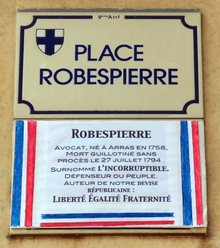
Street names
Robespierre is one of the few revolutionaries not to have a street named for him in the centre of Paris. At the liberation, the municipal council (elected on 29 April 1945 with 27 communists, 12 socialists and 4 radicals out of 48 members), decided on 13 April 1946, to rename the Place du Marché-Saint-Honoré ‘Place Robespierre’, a decision approved at prefectorial level on 8 June. However, in the wake of political changes in 1947, it reverted to its original name on 6 November 1950. Streets in the so-called ‘Red belt’ bear his name, e.g. at Montreuil. There is also a Metro station ‘Robespierre’ on Line 9 (Mairie de Montreuil - Pont de Sèvres), in the commune of Montreuil, named during the era of the Popular Front. There are, however, numerous streets, roads and squares named for him elsewhere in France.
Plaques and monuments
Arras
- On 14 Octobre 1923, a plaque was placed on the house at 9 Rue Maximilien Robespierre (formerly Rue des Rapporteurs) rented by the three Robespierre siblings in 1787–1789, in the presence of the mayor Gustave Lemelle, Albert Mathiez and Louis Jacob. Built in 1730, the house has had a varied history as a typing school, and a craftsmen's museum, but is now being developed as a Robespierre Museum.
- In 1994, a plaque was unveiled by ARBR on the façade of the Carrauts’ brewery on the Rue Ronville, where Maximilien and Augustin were brought up by their grandparents.
- An Art Deco marble bust by Maurice Cladel was intended to be displayed in the gardens of the former Abbey of Saint-Vaast. A mixture of politics and concerns about weathering led to it being placed in the Hôtel de Ville. After many years in a tribunal room, it can now be seen in the Salle Robespierre. Bronze casts of the bust were made for the bicentenary and are displayed in his former home on Rue Maximilien Robespierre and at the Lycée Robespierre, unveiled in 1990.
Paris and elsewhere
- Robespierre is commemorated by two plaques in Paris, one on the exterior of the Duplays’ house, now 398 rue Saint-Honoré, the other, erected by the Société des études robespierristes in the Conciergerie.
- In 1909, a committee presided over by René Viviani and Georges Clemenceau proposed erecting a statue in the garden of the Tuileries, but press hostility and failure to garner enough public subscriptions led to its abandonment. However, Robespierre is recognisable in François-Léon Sicard’s marble Altar of the National Convention (1913), originally intended for the gardens of the Tuileries and now in the Panthéon.
- A stone bust by Albert Séraphin (1949) stands in the square Robespierre, opposite the theatre in Saint-Denis, with the inscription: “Maximilien Robespierre l'Incorruptible 1758-1794”.[482]
- Charles Correia's 1980s bronze sculptural group at the Collège Robespierre in Épinay-sur-Seine depicts him and Louis Antoine de Saint-Just at a table, working on the 1793 Constitution and Declaration of Human Rights.[483] A mural in the school also depicts him.[484]
- In 1986, Claude-André Deseine’s terracotta bust of 1791 was bought for the new Musée de la Révolution française at Vizille. This returned to public view Robespierre's only surviving contemporary sculpted portrait. A plaster cast of it is displayed at the Conciergerie in Paris, and a bronze cast is in the Place de la Révolution Française in Montpellier, with bronzes of other figures of the time.[485]
Resistance units
In the Second World War, several French Resistance groups took his name: the Robespierre Company in Pau, commanded by Lieutenant Aurin, alias Maréchal; the Robespierre Battalion in the Rhône, under Captain Laplace; and a maquis formed by Marcel Claeys in the Ain.
Notes
- Most of the arrests during the Reign of Terror came from Bertrand Barère, Lazare Carnot and Pierre Louis Prieur; most of the orders dealing with supply, transport, munition for the army and navy from Robert Lindet, Carnot and Prieur.
- Baptized Marie Marguerite Charlotte de Robespierre, at the time of her brother's prominence, she was betrothed to Joseph Fouché, who broke the engagement after the events of 9 Thermidor. Charlotte never married and died aged 74.
- Baptized Henriette Eulalie Françoise de Robespierre, was educated with Charlotte at the couvent des Manarres in Tournai and died age 18.
- Returning at intervals, living in Mannheim around 1770, he was buried on 6 November 1777 in the Salvatorkirche in Munich.
- De Montesquieu praised the virtues of the citizen-soldier in his "Reflections on the Grandeur and Decline of the Romans" (1734).[26] In 1762 Rousseau published The Social Contract and Emile, or On Education which were both burned and banned. At the end of the Seven Years' War Mably published his "Conversations with Phocion" in Amsterdam (1763). He wished (for Classical Athens but it looks like Sparta): May our republic be a military one; may each citizen be designed to defend his fatherland; may he be exercised each day how to handle his weapons; may he learn in the town the discipline that is necessary in the camp. By such a policy you would not only educate invincible soldiers but you would give another new force to law and to civic virtues.[27][28] Rousseau and Gabriel Bonnot de Mably were both invited to submit suggestions for the reformation of Poland's unique "Golden Liberty", leading to Rousseau's Considerations on the Government of Poland (1772). In the same year Guibert defined the citizen-in-arms as virtuous by his attachment to the community (in contrast to the mercenary).
- According to apocryphal Mémoires authentiques he was elected as president of the Arras Academy early 1789.[40]
- The Third Estate had as many deputies as the other two orders together (in the ratio 4:4:8) on instigation of Jacques Necker.
- The first use of the motto "Liberté, égalité, et fraternité" was in Robespierre's speech "On the organisation of the National Guard" on 5 December 1790, article XVI,[80] and disseminated widely throughout France by Camille Desmoulin in his journal "Les révolutions de France et de Brabant" among the associated Societies.
- The ordinance, designed to demonstrate the disinterested patriotism of the framers of the new constitution, accelerated political change: the Constituent Assembly was derived from the Estates-General, and so included a large number of nobles and clergy, many of whom were conservative in outlook. Banning all of the now experienced national politicians from the new legislature meant that this new body would be drawn largely from those who had made a name for themselves in the years since the Constituent Assembly was convened, revolutionaries active in local politics, so this ordinance had the effect of shifting the political orientation of the national legislature to the left.[96]
- In September 1792, his younger sister and brother joined him and lived in the front house, but Charlotte insisted on moving to 5 Rue St Florentin because of his increased prestige and her tensions with Madame Duplay.[66]
- The selling of all sorts of positions, military or otherwise, was rampant in the courts of the Ancien Régime and so the officer corps’ mass exodus from France naturally coincided with that of the aristocrats. Not all aristocrats were officers, but all officers were aristocrats.[138]
- The average age of the 24 deputies from Paris was 43. Robespierre was 34, Danton 33 and Marat 49.
- 19 Girondins, ten members of the Commission of Twelve and two ministers, Lebrun and Clavière.
- Condorcet the main author of the first draft was accused of federalism had to go into hiding early July.[257] At the end of August rebellious Marseille, Bordeaux and Lyon had not accepted the new Constitution. By mid September the Jacobin club suggested not to publish the Constitution with the argument the General will was missing. Although an overwhelming majority favored it.[258] The choice seem to have been either a Convention without a Constitution or Constitution without a Convention.[259]
- Barère voiced the Committee of Public Safety's support for the measures desired by the assembly. He presented a decree that was passed immediately, establishing a paid armed force of 6,000 men and 1,200 gunners ‘designed to crush the counter-revolutionaries, to execute wherever the need arises the revolutionary laws and the measures of public safety that are decreed by the National Convention, and to protect provisions.[265] Barère exclaimed: "Let's make terror the order of the day!" but terror was never formally instituted as a legal policy by the Convention, more deployed as a concept.[266]
- On 16 March Robespierre was sharply critical of Amar's report, which presented the scandal around Fabre and Chabot as purely a matter of fraud. Robespierre insisted that it was a foreign plot, demanded that the report be re-written, and used the scandal as the basis for rhetorical attacks on William Pitt the Younger he believed was involved.[319]
- On 27 March on proposal of Barère the armée revolutionnaire, for seven months active in Paris and surroundings, was disbanded, except their artillery.[322][323][324][325] Their infantry and cavallery seem to be merged with other regiments.
- On 9 Thermidor Vadier used a letter—supposedly found under the mattress of Théot—as an opportunity to attack Robespierre and his beliefs.[400] This letter announced to him that his mission had been prophesied in Ezekiel, that the re-establishment of religion, freed of priests, was owning to him.[401] By stating that Robespierre was the "herald of the Last Days, prophet of the New Dawn"[400] (because his festival had fallen on the Pentecost, traditionally a day revealing "divine manifestation"), Catherine Théot made it seem that Robespierre had made these claims himself, to her. She also claimed that he was a reincarnation of Saul, the saviour of Israel, and the chosen of God.[402] Vadier becoming increasingly trivial was stopped by Tallien.[403]
- A coloured print but with a different caption on this cold case can be seen here.[441]
- (in French) Landrucimetieres.fr. A plaque indicating the former site of this cemetery is located at 97 rue de Monceau, Paris. Between 1844 and 1859 (probably in 1848), the remains of all those buried there were moved to the Catacombs of Paris.
References
- Moore 2007, pp. 24, 53, 217.
- O'Brien, James Bronterre (1837). The Life and Character of Maximilian Robespierre. Proving ... that that Much Calumniated Person was One of the Greatest Men ... pp. 415–421.
- "Maximilien Robespierre". Encyclopedia Britannica.
- Jordan, David P. (16 October 2013). Revolutionary Career of Maximilien Robespierre. Simon & Schuster. ISBN 9781476725710 – via Google Books.
- Cobban, Alfred (1 January 1946). "The Political Ideas of Maximilien Robespierre during the Period of the Convention". The English Historical Review. LXI (CCXXXIX): 45–80. doi:10.1093/ehr/LXI.CCXXXIX.45.
- Robespierre by Patrice Gueniffey, p. 306. In: A Critical Dictionary of the French Revolution. Edited by François Furet and Mona Ozouf
- The Works: With Memoirs of His Life and Writings by Robert Anderson, Volume 3 by John Moore, p. 377-379
- The Enlightenment that Failed: Ideas, Revolution, and Democratic Defeat ... By Jonathan I. Israel, p. 483
- The French Revolution: Faith, Desire and Politics by Noah Shusterman, p. 147
- Revolutionary Career of Maximilien Robespierre by David P. Jordan
- Walter, G. (1961) Robespierre, p. 91-93. In: Robespierre, vol. II. L’œuvre, part III. Gallimard.
- R.R. Palmer (1973) The Twelve who ruled, p. 402. Princeton University Press
- Gueniffey : «Robespierre incarne d'une façon chimiquement pure l'idée de la table rase» Published on June 16, 2016 in Le FigaroVox
- Popkin, Jeremy D. (1 July 2016). A Short History of the French Revolution. Routledge. p. 71. ISBN 978-1-315-50892-4.
- Serna 2005, p. 370.
- "Aux origines d'une mémoire républicaine de Robespierre, Hervé Leuwers*". PCF.fr.
- Lavoine, A. (1914) La famille de Robespierre et ses origines. Documents inédits sur le séjour des Robespierre à Vaudricourt, Béthune, Harnes, Hénin-Liétard, Carvin et Arras. (1452–1790). In: Revue du Nord, tome 5, n°18, May 1914. p. 114. doi:10.3406/rnord.1914.1244
- Lavoine, A. (1914) La famille de Robespierre et ses origines. Documents inédits sur le séjour des Robespierre à Vaudricourt, Béthune, Harnes, Hénin-Liétard, Carvin et Arras. (1452–1790). In: Revue du Nord, tome 5, n° 18, May 1914. p. 135
- McDonald, James Damian (1 January 2007). L' Immortalité de l'âme dans la conception religieuse de Maximilien Robespierre [The Immortality of the soul in Maximilien Robespierre's religious thought] (doctoral thesis) (in French). Strasbourg 2. p. 16. OCLC 494639395.
- Scurr 2006, p. 20.
- Carr 1972, p. 10.
- Scurr 2006.
- Hippler, Thomas (2008) Citizens, soldiers and National Armies, p. 28-45
- Jenkins 2011.
- Sonenscher, M. (2008) Sans-Culottes, an eighteenth-century emblem in the French Revolution, p. 231
- The Reemergence of the Citizen-Soldier in Modern Military Theory by Kevin Brown, p. 12
- Citizens, Soldiers and National Armies: Military Service in France and ... by Thomas Hippler, p. 33
- Phocion's Conversations: or, the relation between morality and politics, p. 155
- The Enlightenment that Failed: Ideas, Revolution, and Democratic Defeat ... By Jonathan I. Israel, p. 465-467
- Scurr 2006, pp. 22, 35.
- Riskin, Jessica (1999). "The Lawyer and the Lightning Rod" (PDF). Science in Context. Cambridge University Press (CUP). 12 (1): 61–99. doi:10.1017/s0269889700003318. ISSN 0269-8897.
- Drival, Eugène Van (1872). Histoire de l'Académie d'Arras depuis sa fondation: en 1737, jusqu'à nos jours. Typ. de A. Courtin. p. 58.
- Leuwers, Hervé. Robespierre (Paris, Fayard, 2014; rééd. Pluriel, 2016) — extraits. p. 9 – via www.academia.edu.
- "The Factums of Robespierre the Lawyer. Choices of Defence by Printed Legal Brief by Hervé Leuwers".
- Drival, Eugène Van (1872). Histoire de l'Académie d'Arras depuis sa fondation: en 1737, jusqu'à nos jours. Typ. de A. Courtin. p. 62.
- O'Brien, James Bronterre (1837). The Life and Character of Maximilian Robespierre. Proving ... that that Much Calumniated Person was One of the Greatest Men ... p. 122.
- Jordan, David P. (15 July 1989). The Revolutionary Career of Maximilien Robespierre. University of Chicago Press. pp. 32–33. ISBN 9780226410371 – via Internet Archive.
- The Revolutionary Ascetic: Evolution of a Political Type by Bruce Mazlish, p. 86
- Andress, David (22 January 2015). The Oxford Handbook of the French Revolution. OUP Oxford. ISBN 9780191009921 – via Google Books.
- Reybaud, Charles; Robespierre, Maximilien de (1830). Mémoires authentiques de Maximilien de Robespierre. Moreau-Rosier. p. 279.
- Liste des noms et qualités de messieurs les députés et suppléants à l'Assemblée nationale. In: Archives Parlementaires de 1787 à 1860 — Première série (1787–1799) sous la direction de Jérôme Mavidal et Emile Laurent. Tome VIII du 5 mai 1789 au 15 septembre 1789. Paris : Librairie Administrative P. Dupont, 1875. p. VII.
- Craiutu, Aurelian (26 February 2012). A Virtue for Courageous Minds: Moderation in French Political Thought, 1748–1830. Princeton University Press. pp. 119–21. ISBN 978-1400842421 – via Google Books.
- The French Revolution: A Very Short Introduction by William Doyle
- Brittanica.com
- Schama 1989, p. 354.
- Hibbert, C. (1980) The French Revolution, p. 55.
- A Self-Defining Bourgeoisie in the Early French Revolution: The Milice bourgeoise, the Bastille Days of 1789, and their Aftermath by Micah Alpaugh. In: Journal of Social History, 2014
- Florence Devenne, « La garde Nationale ; création et évolution (1789-août 1792) », Annales historiques de la Révolution française. N°283, 1990. p. 50
- The Making of the Sans-culottes: Democratic Ideas and Institutions in Paris ... by R.B. Rose, p. 54
- Bulletin de l’Assemblée nationale, 15 juillet 1789
- Discussion suite à la motion de M. de Lally-Tollendal relative à l'établissement d'une milice bourgeoise, lors de la séance du 20 juillet 1789
- Discussion suite à la motion de M. de Lally-Tollendal relative à l'établissement d'une milice bourgeoise, lors de la séance du 20 juillet 1789. In: Archives Parlementaires de 1787 à 1860 - Première série (1787-1799) Tome VIII du 5 mai 1789 au 15 septembre 1789. Paris : Librairie Administrative P. Dupont, 1875. pp. 253–255.
- Bulletin de l’Assemblée nationale, 20 juillet 1789, p. 9
- Mémoires authentiques de Maximilien Robespierre: ornés de son portrait et de ... by Maximilien de Robespierre, p. 522
- Maximilien Robespierre: Oeuvres - N° 52
- Moore 2007, p. 38.
- "Robespierre, "Speech Denouncing the New Conditions of Eligibility," 22 October 1789 · Liberty, Equality, Fraternity". chnm.gmu.edu.
- Fehér, Ferenc (1 January 1990). The French Revolution and the Birth of Modernity. University of California Press. pp. 108–109. ISBN 9780520071209 – via Google Books.
- "Robespierre, "Speech Denouncing the New Conditions of Eligibility"". Liberty, Equality, Fraternity. 22 October 1789. Archived from the original on 23 January 2019. Retrieved 16 August 2019.
- "Maximilien Robespierre". eHISTORY. Ohio State University. 1998. Retrieved 16 August 2019.
- Leuwers, Hervé. Robespierre (Paris, Fayard, 2014; rééd. Pluriel, 2016) — extraits. 29 (Compte rendu par Malcolm Crook, In: French History, 2015 ed.). pp. 396–97 – via www.academia.edu.
- Dumont, Etienne (1832). Souvenirs sur Mirabeau et sur les deux premières assemblées législatives. C. Gosselin. pp. 61–62.
- Moore 2007, p. 24.
- https://histoire-image.org/fr/etudes/club-jacobins-paris
- La Maison de Robespierre, rue de Saintonge, à Paris by Georges Michon. In: Annales historiques de la Révolution française (Jan.–Feb. 1924), pp. 64–66
- "Charlotte Robespierre's Memoirs". 24 March 2007.
- Scurr 2006, p. 114.
- P. McPhee (2013) "My Strength and My Health Are not Great Enough": Political Crises and Medical Crises in the Life of Maximilien Robespierre, 1790-1794
- Aulard, François-Alphonse (1897). La société des Jacobins: Mars à novembre 1794. Recueil de documents pour l'histoire du club des Jacobins de Paris (in French). 6. Librairie Jouaust. pp. 714, 717. OCLC 763671875.
- Walter, G. (1961) Robespierre à la tribune, p. 206. In: Robespierre, vol. II. L’œuvre, part IV. Gallimard.
- Thouret Jacques-Guillaume. Adresse de la commune et de la garde nationale d'Arras, lors de la séance du 11 mai 1790 au soir, p. 489
- William J. Murray (1986) The right-wing press in the French Revolution 1789-792 Royal Historical Society Studies in History 44, p. 107
- Petites et Grandes Révolutions de la Famille de Milly: Recherches sur et ... by Alexandre Blondet, p. 181, 185
- Les lundis révolutionnaires: 1790 by Jean-Bernard, p. 250-251
- Smith, John Stores (1848). Mirabeau: A Life-history, in Four Books. Philadelphia: Lea and Blanchard. p. 336.
- Robespierre and War, a Question Posed as Early as 1789? by Thibaut Poirot. In: Annales historiques de la Révolution française 2013/1 (No. 371)
- Fatal Purity: Robespierre and the French Revolution by Ruth Scurr
- Œuvres complètes de Maximilien de Robespierre, tome 6, p. 642
- The Strange History of the Right to Bear Arms in the French Revolution by Noah Shusterman, p. 9
- Discours sur l'organisation des gardes nationales par Maximilien Robespierre
- Nationalism in the Age of the French Revolution by Otto Dann, pl. 28
- Fair Shares for All: Jacobin Egalitarianism in Practice by Jean-Pierre Gross, p. 46
- Goupil de Préfeln Guillaume François. Adoption de divers articles additionnels au décret général sur le rachat des rentes foncières, lors de la séance du 18 décembre 1790. In: Archives Parlementaires de 1787 à 1860 - Première série (1787-1799) Tome XXI - Du 26 novembre 1790 au 2 janvier 1791. Paris : Librairie Administrative P. Dupont, 1885. p. 532. www.persee.fr/doc/arcpa_0000-0000_1885_num_21_1_9450_t1_0532_0000_9
- Walter, G. (1961) Robespierre à la tribune, p. 220, 223. In: Robespierre, vol. II. L’œuvre, part IV. Gallimard.
- https://www.retronews.fr/frequence_terme#
- The Life and Character of Maximilian Robespierre. Proving ... that that Much ... by James Bronterre O'BRIEN, p. 417-421
- Walter, G. (1961) Robespierre à la tribune, p. 234, 235. In: Robespierre, vol. II. L’œuvre, part IV. Gallimard.
- Kappelsberger, Florian. "Albert Mathiez: "Robespierre."" – via www.academia.edu. Cite journal requires
|journal=(help) - "Robespierre and War, a Question Posed as Early as 1789? by Thibaut Poirot".
- Discours par Maximilien Robespierre – 27 avril 1791-28 avril 1791
- O'Brien, James Bronterre (1837). The Life and Character of Maximilian Robespierre. Proving ... that that Much Calumniated Person was One of the Greatest Men ... pp. 422–438.
- Journal des débats et des décrets. 20. Impr. Nationale. 1791. pp. 28, 70–79.
- O'Brien, James Bronterre (1837). The Life and Character of Maximilian Robespierre. Proving ... that that Much Calumniated Person was One of the Greatest Men ... pp. 439–446.
- Linton 2013, pp. 97-99.
- N. Hampson (1978) Danton, p. 44
- Scurr 2006, p. 136.
- Edelstein, Melvin (9 March 2016). The French Revolution and the Birth of Electoral Democracy. Routledge. p. 48. ISBN 9781317031277 – via Google Books.
- The Choices of Maximilien Robespierre by Marisa Linton
- Peter McPhee, « « Mes forces et ma santé ne peuvent suffire ». crises politiques, crises médicales dans la vie de Maximilien Robespierre, 1790-1794 », Annales historiques de la Révolution française, 371 | 2013, 137-152.
- Sonenscher, Michael (2008). Sans-culottes: An Eighteenth-century Emblem in the French Revolution. Princeton University Press. p. 339. ISBN 978-0-691-12498-8.
- Bernstein, Samuel (1955). French Political and Intellectual History. Transaction Publishers. p. 21. ISBN 978-1-4128-2396-8.
- Charavay, Étienne (1890). Assemblée électorale de Paris, 18 novembre 1790-15 juin 1791 (in French). D. Jouaust. pp. XLVI–XLV. OCLC 763860103.
- Mémoires authentiques de Maximilien Robespierre, p. 527
- Cordeliers and Girondins: the prehistory of the republic by fr:Patrice Gueniffey. In: The Invention of the Modern Republic by Biancamaria Fontana, p. 91-92
- Walter, G. (1961) Le vaincu du neuf Thermidor, p. 36. In: Robespierre. L’œuvre, vol. II, part III. Gallimard.
- Discours de Danton, p. 152
- J. Israel (2014) p. 206
- "Rodama: a blog of 18th century & Revolutionary French trivia: Robespierre chez Duplay - No.366 rue Saint-Honoré". 22 September 2017.
- "Élisabeth Le Bas's Memoirs (Part III)". 13 January 2008.
- Mémoires de Charlotte Robespierre sur ses deux frères, pp. 90–91
- Robespierre 2006.
- Hampson 1974, p. 87.
- Schama 1989, pp. 576–577, 579–580.
- Collection Musée de Versailles
- Hampson 1974, p. 99.
- Haydon & Doyle 2006, p. 130, in "Robespierre, the war and its organization" by Forrest, A.
- Schama 1989, p. 594.
- Moore 2007, p. 117.
- Bell 2007, p. 118.
- Haydon & Doyle 2006, in "Robespierre, the war and its organization" by Forrest, A.
- Robespierre, Maximilien (1819). Recueil des œuvrès de Max. J. Robespierre, et de pièces pour servir à son histoire. Recueillis, 1819. p. 35.
- Neil Jaffares, dictionary of pastellist before 1800
- Cromer "Le secret du physoniotrace" Bulletin de la société archéologique, historique et artistique, "Le Vieux Papier", 26th year, October 1925
- Hampson 1974, p. 103.
- Cobb, R. (1987) The People's Armies, p. 22. Yale University Press
- Robespierre, Maximilien (1819). Recueil des œuvrès de Max. J. Robespierre, et de pièces pour servir à son histoire. Recueillis, 1819. p. 45.
- Linton 2013, p. 108.
- V. Aulard (1892) Jacobins, III, p. 526
- Hampson 1974, pp. 180-181.
- Linton 2013, pp. 119-120.
- Hampson 1974, pp. 107-108.
- H. Leuwers (2014) Robespierre, p. 211
- Gough, Hugh (10 June 2016). The Newspaper Press in the French Revolution. Taylor & Francis. p. 87. ISBN 978-1-317-21491-5.
- Scurr, Ruth (17 April 2007). Fatal Purity: Robespierre and the French Revolution. Henry Holt and Company. p. 291. ISBN 978-1-4668-0578-1.
- Lang, Timothy, "Rousseau and the Paradox of the Nation-State" (2018). History Open Access Publications. 2. https://scholarworks.umass.edu/history_oapubs/2 pp. 10, 14, 24
- Soboul 2005, in "Defenseur de la Constitution" by Mazauric, C..
- I. Davidson, p. 86
- ""Friends, Fellows, Citizens. and Soldiers": The Evolution of the French Revolutionary Army, 1792–1799 by WILLIAM SCUPHAM" (PDF).
- Haydon & Doyle 2006, pp. 133–36, in "Robespierre, the war and its organization" by Forrest, A..
- Snyder, Claire R. (28 August 1999). Citizen-Soldiers and Manly Warriors: Military Service and Gender in the Civic Republican Tradition. Rowman & Littlefield Publishers. pp. 46, 55. ISBN 978-0-7425-7353-6.
- Haydon & Doyle 2006, p. 162, in "Robespierre and the Terror" by Hampson, N.
- Robespierre, Oeuvres complètes, volume 4, p. 138, 143
- Pfeiffer 1913, p. 221.
- Taine, H. (2011) The Origins of Contemporary France, p. 298.
- Laurent 1939, pp. 165–66, in Volume IV.
- Schama 1989, p. 252.
- Kennedy 1981, pp. 254–55.
- "The Myth of the Foreign Enemy? The Brunswick Manifesto and the Radicalization of the French Revolution," French History 25, no. 2 (2011): 188-213 by Elisabeth Cross
- Lazare Carnot, republican patriot, by Huntley Dupre, p. 48
- Le Logographe, 1 aôut 1792; Gazette nationale ou le Moniteur universel, 2 août 1792
- Collection Complète des Lois, Décrets, Ordonnances, Réglements, p. 330
- Miller, Melanie Randolph (2011). Envoy to the Terror: Gouverneur Morris and the French Revolution. Potomac Books, Inc. p. 373. ISBN 978-1-61234-277-1.
- Max Gallo (2007) Robespierre, p. 169
- R. Cobb, p. 150
- N. Hampson (1978) Danton, p. 72
- Soboul 2005, p. 363, in "Dix Aout" by Monnier, R.
- N. Hampson (1978) Danton, p. 74
- Hampson 1974, p. 120.
- I. Davidson, p. 109
- Jordan, David P. (15 July 1989). The Revolutionary Career of Maximilien Robespierre. University of Chicago Press. pp. 112–113. ISBN 978-0-226-41037-1.
- "The journée of 20 June, the Brunswick Manifesto, the taking of the Tuileries, the end of the monarchy, the September massacres - A People's History of the French Revolution". erenow.net.
- Hampson 1974, p. 121.
- Le Moniteur universel, t. XIII, n° 241, du 28 aôut, p. 540
- Rachel Rogers (2012) Vectors of Revolution: The British Radical Community in Early Republican Paris, 1792–1794, p. 467
- R. Dupuy (2010) La Garde nationale 1789-1872. Paris, Gallimard, ISBN 978-2-07-034716-2
- "F. Furet & M. Ozouf (1989) A Critical Dictionary of the French Revolution, p. 139" (PDF).
- Israel 2014, p. 266.
- Israel 2014, p. 267.
- Israel 2014, p. 268.
- Hardman, John (1999). Robespierre. Longman. pp. 56–57. ISBN 978-0-582-43755-5.
- Hampson 1974, p. 126.
- Staël, Anne-Louise-Germaine de (1818). Considerations on the Principal Events of the French Revolution. Baldwin, Cradock, and Joy. p. 70.
- Assemblée Nationale
- J. Israel (2014), Revolutionary Ideas, p. 632–633.
- Charavay, Étienne (1905). Assemblée électorale de Paris 2 septembre 1792-17 frimaire an II (in French). D. Jouaust. p. xvi. OCLC 764234804.
- France and Its Revolutions: A Pictorial History 1789–1848 by George Long, p. 206–207
- S. Loomis, p. 74, 81, 96, 143, 207
- Israel, Jonathan (23 March 2014). Revolutionary Ideas: An Intellectual History of the French Revolution from The Rights of Man to Robespierre. Princeton University Press. p. 272. ISBN 978-1-4008-4999-4.
- Assemblée électorale de Paris, p. XVI
- The French Revolution: From Enlightenment to Tyranny by Ian Davidson, p. xiv, 126
- Mémoires de Charlotte Robespierre sur ses deux frères, p. 76
- Jacques Pierre Brissot in America and France, 1788–1793: In Search of Better ... by Bette W. Oliver, p. 112
- J.F. Bernard (1973) Talleyrand: a biography, p. 106
- Robespierre, Maximilien; Laponneraye, Albert; Carrel, Armand (1840). Oeuvres. Worms. p. 98.
- The French Legislative Assembly of 1791 by C. J. Mitchell, p. 174
- Dart, Gregory (26 September 2005). Rousseau, Robespierre and English Romanticism. Cambridge University Press. pp. 43–46. ISBN 9780521020398 – via Google Books.
- "Maximilien, François, Marie, Isidore, Joseph de Robespierre — Base de données des députés français depuis 1789 — Assemblée nationale". www2.assemblee-nationale.fr.
- Charavay, Étienne (1905). Assemblée électorale de Paris 2 septembre 1792-17 frimaire an II (in French). D. Jouaust. p. xxiv. OCLC 764234804.
- Robespierre 1958, pp. 83–84, in Tome IX, Discours.
- Robespierre 1958, pp. 88–89, in Tome IX, Discours.
- Shusterman, N. C. (2014). "All of His Power Lies in the Distaff: Robespierre, Women and the French Revolution". Past & Present. 223 (1): 129–160. doi:10.1093/pastj/gtu001 – via www.academia.edu.
- Moore, John; Anderson, Robert (1820). A journal during a residence in France ... 1792. Stirling & Slade. p. 473.
- Kennedy 1988, pp. 308–10.
- Robespierre 1958, pp. 104–05, 120., in Tome IX, Discours.
- Soboul 2005, p. 42, in "Armoir de Fer" by Grendron, F..
- Hardman, John (2016) The life of Louis XVI, p. ?
- Thompson 1988, pp. 292–300.
- Robespierre 1958, pp. 121–22, in Tome IX, Discours.
- Soboul 2005, p. 867, in "Procès du Roi" by Dorigny, M.
- Robespierre 1958, pp. 129–30, in Tome IX, Discours.
- William J. Murray (1986) The right-wing press in the French Revolution 1789-792 Royal Historical Society Studies in History 44, p. 1
- P. McPhee (2016) Liberty or Death, p. 172
- Oeuvres de Maximilien Robespierre, Band 9 by Maximilien Robespierre,p. 263-264
- Scurr 2006, pp. 249–51.
- L. Moore, p. 172
- I. Davidson, p. 108, 150
- Dinwiddy, J. R. (1 July 1992). Radicalism and Reform in Britain, 1780-1850. A&C Black. ISBN 9780826434531 – via Google Books.
- P.C. Howe (1982) Foreign Policy and the French Revolution, p. 175-176
- France and Its Revolutions: G. Long (1850) A Pictorial History 1789-1848, p. 265
- Walter, G. (1961) Robespierre à la tribune, p. 280-281. In: L’œuvre, vol. II, part IV. Gallimard.
- Davidson, I. (2016) The French Revolution, p. 155-156. PROFILE BOOKS LTD. Kindle Edition.
- I. Davidson, p. 157
- Hampson 1974, pp. 144-146.
- "From victory to defeat, the declaration of war against England and Spain, the insurrection in the Vendée, the fall of the Gironde - A People's History of the French Revolution". erenow.net.
- Robespierre 1958, pp. 358, 383, in Tome IX, Discours.
- N. Hampson (1978) Danton, p. 118
- Walter, G. (1961) Le vaincu du neuf Thermidor, p. 51-52, 63. In: L’œuvre, vol. II, part III. Gallimard.
- Fair Shares for All: Jacobin Egalitarianism in Practice by Jean-Pierre Gross, p. 37
- "The dramas of Germinal and Thermidor - A People's History of the French Revolution". erenow.net.
- Collection complète des lois, décrets, ordonnances, réglemens, p. 325
- Davidson, Ian. The French Revolution, p. 157
- Thermomètre du jour 2 mai 1793
- Histoire de la Révolution française, Volume 2 by Louis Jean Joseph Blanc, p. 196
- Davidson, Ian. The French Revolution, p. 159.
- Robespierre 1958, pp. 490, 492, 514–515, 517, 543, in Tome IX, Discours.
- Schama 1989, p. 720.
- The Cambridge Modern History, Band 8, p. 271
- Slavin, Morris (9 September 1986). The Making of an Insurrection: Parisian Sections and the Gironde. Harvard University Press – via Internet Archive.
morris slavin.
- Ternaux, Mortimer (1869). Histoire de la terreur, 1792-1794. Vol 7. Michel Lévy frères. p. 266.
- N. Hampson (1978) Danton, p. 113
- Israel 2014, p. 442.
- Schama 1989, p. 722.
- Ternaux, Mortimer (1869). Histoire de la terreur, 1792-1794. Vol 7. Michel Lévy frères. p. 276.
- Soboul 1974, p. 309.
- R.R. Palmer (1973) The Twelve who ruled, p. 32. Princeton University Press
- Robespierre 1958, p. 543, in Tome IX, Discours.
- Davidson, Ian. The French Revolution, p. 160
- Davidson, Ian. The French Revolution, p. 161
- Roger Dupuy (2010) La Garde nationale 1789-1872. Paris, Gallimard, ISBN 978-2-07-034716-2
- Kennedy, Michael (1 May 2000). The Jacobin Clubs in the French Revolution, 1793-1795. Berghahn Books. p. 17. ISBN 978-1-78920-576-3.
- Popkin, Jeremy D. (1 July 2016). A Short History of the French Revolution. Routledge. pp. 66–67. ISBN 978-1-315-50892-4.
- Le Républicain français, 14 septembre 1793, p. 2
- de LaBédollière, Emile (1848). Histoire de la Garde nationale: récit complet de tous les faits qui l'ont distinguée depuis son origine jusqu'en 1848 (in French). H. Dumineray et F. Pallier. OCLC 944662819.
- Israel 2014, p. 447.
- Davidson, Ian. The French Revolution, p. 161-162
- Walter, G. (1961) Robespierre à la tribune, p. 288
- C.L.R. James (1938) The Black Jacobins: Toussaint L'Ouverture, p. 138
- Hampson 1974, p. 150.
- Thompson, J. M. (28 June 2017). Robespierre. Vol 2. Borodino Books. p. 428. ISBN 978-1-78720-518-5.
- Baczko, Bronislaw (1994). Ending the Terror: The French Revolution After Robespierre. Cambridge University Press. p. 208. ISBN 978-0-521-44105-6.
- Rudé 1975.
- Histoire de la revolution Française, Volume 8 by Jules Michelet, p. 37
- Hampson 1974, pp. 157, 175, 225.
- Raphael Matta Duvignau, "The Committee of public safety (6th April 1793 — 4th brumaire an IV)", The French Revolution [online], 3 | 2012, online since 20 December 2012, accessed 25 February 2019. DOI : 10.4000/lrf.773
- FRENCH CONSTITUTION of the twenty-fourth of June, 1793
- Schama 1989, p. 750.
- Jonathan Israel, Revolutionary Ideas: An Intellectual History of the French Revolution ... , Chapter XIII, p. 371–374
- Contesting the French Revolution by Paul R. Hanson, p. 100-101
- Annales patriotiques et littéraires de la France, et affaires politiques de l’Europe 17 septembre 1793, p. 3
- Mandats à l’Assemblée nationale ou à la Chambre des députés
- Jordan, David P. (15 July 1989). The Revolutionary Career of Maximilien Robespierre. University of Chicago Press. pp. 156. ISBN 9780226410371 – via Internet Archive.
- "Augustin, Bon, Joseph de Robespierre - Base de données des députés français depuis 1789 - Assemblée nationale". www2.assemblee-nationale.fr.
- Tackett, Timothy (23 February 2015). The Coming of the Terror in the French Revolution. Harvard University Press. p. 299. ISBN 9780674736559 – via Google Books.
- Richard T. Bienvenu (1968) The Ninth of Thermidor, p. 22; R.R. Palmer (1970) The Twelve who ruled, p. 47-51
- June to October 1793. The ‘federalist’ uprisings, the Committee of Public Safety, the assassination of Marat, the Enragés and the popular movement, the general maximum
- A Natural History of Revolution: Violence and Nature in the French revolutionary imagination, 1789-1794 by Mary Ashburn Miller, p. 200
- Hampson 1974, p. 198.
- Macroeconomic Features of the French Revolution by Thomas J. Sargent and François R. Velde. In: Journal of Political Economy, Vol. 103, No. 3 (Jun. 1995). Published by: The University of Chicago Press. JSTOR 2138696 pp. 504–05
- Davidson, Ian. The French Revolution, p. 188
- Cobb, R. (1987) The People's Armies, p. 48, 52
- Journal des débats et des décrets 3 octobre 1793
- Feuille du salut public 4 octobre 1793, p. 2
- Walter, G. (1961) Robespierre à la tribune, p. 301
- Robespierre by Patrice Gueniffey, p. 312. In: A Critical Dictionary of the French Revolution. Edited by François Furet and Mona Ozouf
- Histoire de la revolution Française, Volume 8 by Jules Michelet, pp. 33–34, 53
- Le Moniteur Universel 11/10/1793, p. 2
- Hodges, Donald Clark (25 April 2003). Deep Republicanism: Prelude to Professionalism. Lexington Books. p. 94. ISBN 9780739105535 – via Internet Archive.
- -Jacobin-dictatorship Brittanica.com
- Le Moniteur Universel 14/10/1793
- Kennedy, M. L. "The Jacobin Clubs in the French Revolution: 1793–1795," p. 53. Berghahn Books, New York: 2000.
- Davidson, Ian. The French Revolution, p. 187
- Hampson 1974, p. 166.
- Feuille du salut public 4 octobre 1793, p.
- R.R. Palmer (1973) The Twelve who ruled, p. 55
- "Georges Danton | French revolutionary leader". Encyclopedia Britannica.
- Vilate, Joachim (1794). Causes secrètes de la Révolution du 9 au 10 thermidor (in French). pp. 12–13. OCLC 764013318.
- Schama 1989, p. 799.
- The French Revolution: Faith, Desire and Politics. Routledge. 15 October 2013. p. 197. ISBN 9781134455935 – via Google Books.
- LAST LETTER OF MARIE-ANTOINETTE Centre historique des Archives nationale
- Moore 2007, p. 246.
- Richard T. Bienvenu (1968) The Ninth of Thermidor, p. 23
- Hampson, N. (1 January 1976). "François Chabot and His Plot". Transactions of the Royal Historical Society. 26: 3. doi:10.2307/3679069. JSTOR 3679069.
- Hampson 1974, p. 203, 208–209.
- Doyle, William (2002). The Oxford History of the French Revolution. Oxford, UK: Oxford University Press. p. 283. ISBN 978-0-19-925298-5.
- Schama 1989, pp. 652, 656.
- Le Moniteur Universel 6/12/1793
- Non-Violence and the French Revolution: Political Demonstrations in Paris ... by Micah Alpaugh, p. 158
- Le Moniteur Universel de 5 décembre 1793, p. 4
- Le Moniteur Universel de 9 décembre 1793, art. XVIII
- Hampson 1974, p. 217.
- Linton 2013, p. 207.
- Funck, F.; Danton, G.J.; Châlier, M.J. (1843). 1793: Beitrag zur geheimen Geschichte der französischen Revolution, mit besonderer Berücksichtigung Danton's und Challier's, zugleich als Berichtigung der in den Werken von Thiers und Mignet enthaltenen Schilderungen (in German). F. Bassermann. p. 52.
- Davidson, Ian. The French Revolution, p. 211
- Press in the French Revolution by John Thomas Gilchrist, p. 19
- Scurr, 298
- Davidson, Ian. The French Revolution, p. 211
- "Maximilien Robespierre". Encyclopedia Britannica.
- Construire une nouvelle catégorie politique: Robespierre et la théorie du gouvernement révolutionnaire par Hervé Leuwers, p. 12
- G. Rudé (1967) Robespierre, p. 58–67
- "Rousseau, Robespierre, and the French Revolution by James Read, p. 4" (PDF).
- Popkin, Jeremy D. (1 July 2016). A Short History of the French Revolution. Routledge. p. 72. ISBN 978-1-315-50892-4.
- R.R. Palmer, p. 264
- [Hodges, Donald Clark (25 April 2003). Deep Republicanism: Prelude to Professionalism. Lexington Books. pp. 91–92. ISBN 9780739105535 – via Google Books.]
- "On the Principles of Political Morality, February 1794". Modern History Sourcebook. 1997.
- "Rousseau, Robespierre, and the French Revolution by James Read, p. 3" (PDF).
- Rude, George (ed.), Robespierre, (Englewood Cliffs: Prentice-Hall, 1967), p. 136.
- ""My Strength and My Health Are not Great Enough": Political Crises and Medical Crises in the Life of Maximilien Robespierre, 1790–1794 by Peter McPhee".
- L. Jacob (1960) Hébert, Le Père Duchesne. Chef des sans-culottes, p. 326.
- Matrat, J. Robespierre Angus & Robertson 1971 p. 242
- Davidson, Ian. The French Revolution, p. 215
- The Morning Chronicle (18 August) and Gazette Nationale ou Le Moniteur Universel (29 July)
- Le Moniteur Universel 28 March 1793
- Collection complète des lois, décrets d'intérêe général, traités ..., Band 7, p. 149
- Cobb, R. (1987) The People's Armies, p. 601, 607, 611, 617
- Nationality and Citizenship in Revolutionary France: The Treatment of Foreigners by Michael Rapport, p. 203
- N. Hampson (1878) Danton, p. 160-161
- Schama 1989, pp. 816-817.
- History of the French Revolution by Adolphe Thiers, p. 426
- Annual Register, Band 36. Published by Edmund Burke, p. 118.
- Linton 2013, p. 226.
- W. Doyle (1990) The Oxford History of the French Revolution, pp. 272–74.
- Gazette nationale ou le Moniteur universel 5 April 1794
- A People's History of the French Revolution by Éric Hazan, p. 361-362, 19
- N. Hampson (1878) Danton, p. 72-73, 163
- Jean-Joseph Gaume (1856) La Révolution, recherches historiques, Quatrième partie, Paris, Gaume frères, pp. 136–37
- "P. McPhee (2013) "My Strength and My Health Are not Great Enough": Political Crises and Medical Crises in the Life of Maximilien Robespierre, 1790–1794. In: Annales historiques de la Révolution française 2013/1 (No. 371)".
- "To What Extent Was Robespierre the Driving Force of the Great Terror?…". coggle.it.
- The French Revolution: From Enlightenment to Tyranny by Ian Davidson, p. xiv
- Linton 2013, p. 235.
- Le republicain francais, 8 juin 1794; Mercure universel, 24 juin 1794
- Gazette nationale ou le Moniteur universel, 11 juin 1794, p. 4
- "Maximilien Robespierre, Master of the Terror". people.loyno.edu.
- Furet & Ozouf 1989b, p. 143.
- Geschichte Der Französischen Revolution von Jules Michelet, p. 119
- Israel 2014, p. 570.
- "Picpus (12)". Paris Cemeteries.
- Steinberg, Ronen (9 September 2008). "Spaces of Mourning:The Cemetery of Picpus and the Memory of Terror in Post-Revolutionary France". Proceedings of the Western Society for French History. 36. hdl:2027/spo.0642292.0036.011.
- Fülöp-Miller, Rene (2013). Leaders, Dreamers And Rebels – An Account Of The Great Mass-Movements Of History And Of The Wish-Dreams That Inspired Them. Read Books Ltd. ISBN 978-1473383692.
- "Robespierre and the Terror | History Today". www.historytoday.com. Retrieved 19 September 2017.
- I. Davidson, p. 81
- McPhee 2012, pp. 86–87.
- Doyle 2002.
- McPhee 2012, p. 113.
- Popkin 2010, pp. 350–70.
- McPhee 2012, pp. 173–74.
- Jordan 2013.
- Scott 1974, p. 107.
- Moore 2007, p. 291.
- Andress 2006, p. 308.
- Michelet, J. The History of the French Revolution (Charles Cocks, trans., 1847 online.
- "Robespierre, M. "The Cult of the Supreme Being", in Modern History Sourcebook, 1997". sourcebooks.fordham.edu.
- Schama 1989, p. 840.
- R.R. Palmer (1970), p. 368
- "Memoirs by Joseph Fouché (1824)".
- G. Rudé (1967) Robespierre, p. 127
- L. Moore, p. 287
- A Peoples' History 1793 – 1844 from the newspapers. The Bombay Courier, Sat 18th Oct. 1794
- Walter, G. (1961) Robespierre, p. 113. In: L’œuvre, vol. II, part III. Gallimard.
- Macdonald, Simon; Jones, Colin (25 September 2018). "Robespierre, the Duke of York, and Pisistratus During the French Revolutionary Terror". The Historical Journal. 61 (3): 643–672. doi:10.1017/S0018246X17000267.
- Schama 1989, p. 836.
- Jean Jaurès, "The Law of Prairial and the Great Terror (Fall, year IV)", in Socialist History of the French Revolution (translated by Mitchell Abidor), Marxists.org
- Lazare Carnot, republican patriot, by Huntley Dupre, p. 185-187
- "Lazare Carnot, French military engineer". Encyclopedia Britannica.
- Petites Chroniques #14 : La Révolution française — 1790 à 1794 ..., Band 14
- Vilate, Joachim (1794). Causes secrètes de la Révolution du 9 au 10 thermidor (in French). p. 39. OCLC 764013318.
- Hardman, John (25 April 1999). Robespierre. Longman. p. 158. ISBN 9780582437555 – via Google Books.
- Albert Soboul (1974) The French Revolution, 1787–1799: From the Storming of the Bastille to Napoleon, pp. ?
- Linton 2013.
- Mathiez, Albert (1910). "La Politique de Robespierre et le 9 Thermidor Expliqués Par Buonarroti". Annales Révolutionnaires. 3 (4): 481–513. JSTOR 41920292.
- Walter, G. (1961) Le vaincu du neuf Thermidor, p. 17. In: L’œuvre, vol. II, part III. Gallimard.
- "II. His Last Speech by Maximilien Marie Isidore Robespierre. Continental Europe (380–1906). Vol. VII. Bryan, William Jennings, ed. 1906. The World's Famous Orations". www.bartleby.com.
- R.R. Palmer, p. 373
- Hampson 1974, p. 293.
- Gazette nationale ou le Moniteur universel 27 July 1794
- Moore 2007, p. 296.
- Cécile Obligi (2016) La légende noire de Robespierre
- Hampson 1974, p. 294.
- "The Encyclopaedia Britannica Or Dictionary of Arts, Sciences, and General Literature". A. and C. Black. 9 September 1842 – via Google Books.
- Davidson, Ian. The French Revolution, p. 228
- Richard T. Bienvenu (1968) The Ninth of Thermidor, p. 175, 183
- Schama 1989, pp. 841–42.
- Hampson 1974, p. 298.
- R.R. Palmer (1970), p. 375
- "Robespierre peint par lui-même".
- G. Rudé (1967) Robespierre, p. 110
- Cobb, Richard, The people's armies: the armées révolutionnaires: instrument of the Terror in the departments, April 1793 to Floréal Year II, trans. Elliott, Marianne(New Haven, CT, and London, 1987), pp. 65–6. Google Scholar
- Tremblay, Jean-Marie (2 February 2005). "Albert Mathiez (1874-1932), La Révolution française : La chute de la Royauté; La Gironde et la Montagne; La Terreur". texte.
- Le Moniteur, 29 July 1794
- Richard T. Bienvenu (1968) The Ninth of Thermidor, p. 190–191, 195, 196
- Andress 2006, p. 323.
- Richard T. Bienvenu (1968) The Ninth of Thermidor, p. 197
- "The Life of Maximilien Robespierre: With Extracts from His Unpublished Correspondence", G.H. Lewes. Chapman and Hall, 1899. p. 358. Retrieved 26 February 2017
- R.R. Palmer (1970), p. 377
- Schama 1989, pp. 842–44.
- Korngold, Ralph 1941, p. 365, Robespierre and the Fourth Estate Retrieved 27 July 2014
- Lallement, Guillaume (1821). Choix de rapports, opinions et discours prononcés à la Tribune Nationale depuis 1789 jusqu'à ce jour. A. Eymery. p. 341.
- Ratineau Fabienne. Les livres de Robespierre au 9 thermidor. In: Annales historiques de la Révolution française, n°287, 1992. pp. 131–135. DOI : https://doi.org/10.3406/ahrf.1992.1479 http://www.persee.fr/doc/ahrf_0003-4436_1992_num_287_1_1479
- Furet 1996, p. 150.
- "Projet de procès-verbal des séances de 9, 10 et 11 thermidor par Charles Duval, p. 34".
- Dupuy, Roger. La Garde nationale (Folio Histoire) (French Edition). Editions Gallimard.
- Sanson, Henri (1876). Memoirs of the Sansons: From Private Notes and Documents (1688-1847). London: Chatto and Windus. OCLC 317736774.
- Richard T. Bienvenu (1968) The Ninth of Thermidor, p. 212
- Baczko, Bronislaw (1994). Ending the Terror: The French Revolution After Robespierre. Cambridge University Press. p. 11. ISBN 978-0-521-44105-6.
- Jourdan, Annie (2 May 2016). "Les journées de Prairial an II : le tournant de la Révolution ?". La Révolution française. Cahiers de l'Institut d'histoire de la Révolution française (10). doi:10.4000/lrf.1591 – via journals.openedition.org.
- Biard, Michel (2015). La liberté ou la mort, mourir en député, 1792-1795. Tallandier. p. 119. ISBN 979-10-210-0844-1.
- Fouche & Robespierre, le 9 thermidor by Arnaud Louis Raoul Comte de Martel, p. 238-239
- Richard T. Bienvenu (1968) The Ninth of Thermidor, p. 235
- "The public prosecutor of the Terror by A.Q. Fouquier-Tinville, p. 117".
- Gazette nationale ou le Moniteur universel 30 July 1794
- Fouquier-Tinville, p. 117
- Gazette nationale ou le Moniteur universel 16 August 1794, p. 4
- Hamel, Ernest (1897). Thermidor: d'après les sources originales et les documents authentiques (in French) (2nd ed.). Flammarion. p. 322. OCLC 764094902.
- Jones, Colin (1 June 2014). "The Overthrow of Maximilien Robespierre and the "Indifference" of the People". The American Historical Review. 119 (3): 689–713. doi:10.1093/ahr/119.3.689.
- Richard T. Bienvenu (1968) The Ninth of Thermidor, p. 223
- Buchez, Philippe-Joseph-Benjamin (1837). Histoire parlementaire de la Révolution Française, ou journal des Assemblées Nationales, depuis 1789 jusqu'en 1815. 34. Paulin. p. 47.
- Campardon, Emile (1862). Histoire du tribunal révolutionnaire de Paris: 10 mars 1793 - 31 mai 1795. p. 129.
- Blanc, Louis Jean Joseph (1869). Histoire de la Révolution française. Libr. Internationale. p. 77.
- E. Hamel, p. 333
- Richard T. Bienvenu (1968) The Ninth of Thermidor, p. 219
- Richard T. Bienvenu (1968) The Ninth of Thermidor, p. 225
- Courtois, Edme Bonaventure (1796). Convention nationale. Rapport fait au nom des Comités de salut public et de sûreté générale, sur les événemens du 9 thermidor, an II. 1.
- Sydenham, Michael J. (1 January 2006). Léonard Bourdon: The Career of a Revolutionary, 1754-1807. Wilfrid Laurier Univ. Press. p. 241. ISBN 978-0-88920-588-8.
- Méda, Charles-André (1825). Précis historique inédit des événemens de la soirée du 9 Thermidor An II. Baudouin. p. 394.
- R.R. Palmer (1970), p. 379
- Edme Bonaventure COURTOIS, Rapport fait au nom des comités de Salut public et de Sûreté générale sur les événements du 9 thermidor an II ..., Paris, imprimerie nationale, an IV, p. 202
- Powell, Burt Eardley (2019). Die Memoiren Von Barras Über Den 9. Thermidor (in German). Fb&c Limited. pp. 45, 48–50. ISBN 978-0-484-93446-6.
- L. Blanc (1861) Histoire de la Révolution Française, Vol. 11, p. 270
- Walter, G. (1961) Robespierre, p. 478. In: Robespierre, vol. I. La Vie. Gallimard.
- Leuwers, Hervé. Robespierre (Paris, Fayard, 2014; rééd. Pluriel, 2016) — extraits. pp. 366–367 – via www.academia.edu.
- Aulard, Alphonse (3 November 2011). Études et leçons sur la Révolution Française. Cambridge University Press. p. 292. ISBN 978-1-108-03497-5.
- Arrestation de Robespierre
- Précis historique inédit des événemens de la soirée du 9 Thermidor An II by Charles-André Méda, p. 384-385
- L. Blanc (1861) Histoire de la Révolution Française, Vol. 11, book 12, ch. 7, p. 256
- Brink 1899, p. 399.
- Memoirs of the Sansons, from private notes and documents, 1688-1847 / edited by Henry Sanson", p. 202-203
- E. Hamel, pp. 337–38
- Arrest of Robespierre by G. Lenotre (Théodore Gosselin)
- Lenotre, G.; Stawell, Rodolph (11 August 2019). "Robespierre's rise and fall;". London, Hutchinson – via Internet Archive.
- C.A. Méda, p. 385
- E. Hamel, p. 342
- Dauban, Charles-Aimé (9 September 2012). Paris en 1794 et en 1795: histoire de la rue, du club, de la famine : composée d'après des documents inédits, particulièrement les rapports de police et les registres du Comité de salut public : avec une introduction. Editorial MAXTOR. ISBN 9791020800565 – via Google Books.
- Lyons, Martyn; Lyons, Malcolm (25 September 1975). France Under the Directory. CUP Archive. ISBN 9780521099509 – via Google Books.
- "La fin tragique de Robespierre et de ses amis le 9 thermidor. - L'ARBR- Les Amis de Robespierre". www.amis-robespierre.org.
- Richard T. Bienvenu (1968) The Ninth of Thermidor, p. 227
- Fouquier-Tinville, pp. 120–22
- Schama 1989, pp. 845–46.
- Israel 2014, p. 580.
- "Arrestation de Robespierre | | Page 3". levieuxcordelier.fr.
- Non-Violence and the French Revolution: Political Demonstrations in Paris ... by Micah Alpaugh, p. 245-246
- "The meaning of 9 Thermidor - A People's History of the French Revolution". erenow.net.
- Ratineau Fabienne. Les livres de Robespierre au 9 thermidor. In: Annales historiques de la Révolution française, n°287, 1992. pp. 131–35. doi:10.3406/ahrf.1992.1479
- Annie Jourdan, « L’épuisement de Robespierre », La Vie des idées, 23 juillet 2012. ISSN 2105-3030. URL : http://www.laviedesidees.fr/L-epuisement-de-Robespierre.html
- A Letter from Danton to Marie Antoinette by Carl Becker. In: The American Historical Review, Vol. 27, No. 1 (Oct. 1921), p. 29 Published by: Oxford University Press on behalf of the American Historical Association JSTOR 1836918
- Israel 2014, p. 586.
- R.R. Palmer (1970) The Twelve who ruled, p. 383, 395
- Kippur, Stephen A. (1 January 1981). Jules Michelet: A Study of Mind and Sensibility. SUNY Press. p. 143. ISBN 978-0-87395-430-3.
- Walter, G. (1961) Robespierre à la tribune, p. 225. In: Robespierre, vol. II. L’œuvre, part IV. Gallimard.
- R.R. Palmer (1970) The Twelve who ruled, p. 396
- Annie Duprat, " Cécile Obligi, Robespierre. The probity revolting ", an historical Record of the French Revolution [online], 370 | October–December 2012, available online 28 January 2013, accessed 7 February 2019. URL : http://journals.openedition.org/ahrf/12537
- Mathiez 1977.
- François Crouzet (1999) Historians and the French Revolution: the case of Maximilien Robespierre, p. 256-261
- Man of the people. Finding the real Robespierre by Patrice Higonnet
- Ishay 1995, p. 65.
- R.R. Palmer (1970) The Twelve who ruled, p. 400
- Linton 2013, p. 229.
- Serna 2005, p. 369.
- Annie Jourdan, « Robespierre, An Indecisive Revolutionary », Books and Ideas, 18 May 2017. ISSN 2105-3030. URL : http://www.booksandideas.net/Robespierre-the-Indecisive.html
- Israel 2014, p. 521.
- The Enlightenment that Failed: Ideas, Revolution, and Democratic Defeat ...by Jonathan I. Israel, 482
- Bean, Horak & Kapse 2014.
- "BookReader - Deep Republicanism: Prelude to Professionalism (Donald C. Hodges)". bookre.org.
- See René & Peter van der Krogt, Statues – Hither & Thither for photographs: https://statues.vanderkrogt.net/object.php?webpage=ST&record=frif030
- See Seine-Saint-Dénis Atlas de l’architecture et du patrimoinefor photographs by Agnès Paty: https://patrimoine.seinesaintdenis.fr/spip.php?page=document&id_document=1028036
- See Département Seine-Saint-Dénis Atlas de l’architecture et du patrimoine: https://patrimoine.seinesaintdenis.fr/spip.php?page=document&id_document=1028019
- See Nella Buscot, sculpteur, Sculptures à Montpellier: http://www.nella-buscot.com/jardins_montpellier_prf_2.php
Sources (selection)
- Andress, David (2006). The Terror: The Merciless War for Freedom in Revolutionary France. Farrar, Straus, and Giroux. ISBN 978-0374273415.CS1 maint: ref=harv (link)
- Aulard, François-Alphonse (1897). La société des Jacobins: Mars à novembre 1794. Recueil de documents pour l'histoire du club des Jacobins de Paris (in French). 6. Librairie Jouaust. OCLC 763671875
- Bienvenu, Richard T. (1968) The Ninth of Thermidor: The Fall of Robespierre. Oxford University Press, New York.
- Blanc, Louis Jean Joseph (1869). Histoire de la Révolution française. Libr. Internationale.
- Courtois, Edme-Bonaventure; Robespierre, Maximilien (1828). Papiers inédits trouvés chez Robespierre, Saint-Just, Payan, etc: supprimés ou omis par Courtois; précédés du rapport de ce député à la Convention nationale; avec un grand nombre de fac-similé et les signatures des principaux personnages de la révolution (in French). Baudouin frères.CS1 maint: ref=harv (link)
- Davidson, Ian (2016) The French Revolution: From Enlightenment to Tyranny. Profile Books Ltd
- Doyle, William (2002). The Oxford History of the French Revolution. Oxford University Press. ISBN 978-0191608292.CS1 maint: ref=harv (link)
- Dunoyer, Alphonse (1913) The public prosecutor of the terror, Antoine Quentin Fouquier-Tinville. New York: G.P. Putnam's sons.
- Furet, François (1989). Interpreting the French Revolution. Cambridge, MA: Harvard University Press. ISBN 978-0521280495. Retrieved 26 January 2014.CS1 maint: ref=harv (link)
- Furet, François; Ozouf, Mona (1989). A Critical Dictionary of the French Revolution. Harvard University Press. ISBN 978-0674177284.CS1 maint: ref=harv (link)
- Hamel, Ernest (1897) Thermidor: d'après les sources originales et les documents authentiques (in French) (2nd ed.). Flammarion. OCLC 764094902
- Hampson, Norman (1974). The Life and Opinions of Maximilien Robespierre. Duckworth. ISBN 978-0715607411.CS1 maint: ref=harv (link)
- Hardman, John (1999) Robespierre. Profiles in power. Longman. ISBN 9780582437555 – via Google Books.
- Haydon, Colin; Doyle, William (2006). Robespierre. Cambridge University Press. ISBN 978-0521026055.CS1 maint: ref=harv (link) A collection of essays covering not only Robespierre's thoughts and deeds, but also the way he has been portrayed by historians and fictional writers alike.
- Reviewed at the Wayback Machine (archived 9 June 2007) by Hilary Mantel in the London Review of Books, Vol. 22, No. 7, p. 30 March 2000.
- Hazan, Eric (2014) A People's History of the French Revolution. Verso. London. New York. ISBN 978-1781689844
- Israel, Jonathan (2014). Revolutionary Ideas: An Intellectual History of the French Revolution from The Rights of Man to Robespierre. Princeton University Press. ISBN 978-1400849994.CS1 maint: ref=harv (link)
- Jordan, David P. (2013). Revolutionary Career of Maximilien Robespierre. Simon & Schuster. ISBN 978-1476725710.CS1 maint: ref=harv (link)
- Kennedy, Michael L. (1988). The Jacobin clubs in the French Revolution: the Middle Years. Princeton University Press. ISBN 978-0691055268.CS1 maint: ref=harv (link)
- Laurent, Gustave (1939). Oeuvres Completes de Robespierre (in French). Nancy: Imprimerie de G. Thomas. OCLC 459859442.CS1 maint: ref=harv (link)
- Leuwers, Hervé (2014) Robespierre. Paris, Pluriel.
- Lewes, G.H. (1849) The life of Robespierre
- Linton, Marisa (2013). Choosing Terror: Virtue, Friendship, and Authenticity in the French Revolution. Oxford University Press. ISBN 978-0-19-957630-2. OCLC 854998068.CS1 maint: ref=harv (link)
- Martin, Jean-Clément (2006). Violence et Révolution: essai sur la naissance d'un mythe national (in French). Paris: Éd. du Seuil. ISBN 978-2020438421.CS1 maint: ref=harv (link)
- Mathiez, Albert (1927). The French Revolution. Williams and Norgate.CS1 maint: ref=harv (link)
- Mathiez, Albert (1977). "Robespierre: l'histoire et la légende". Annales Historiques de la Révolution Française. 49 (227): 5–31. doi:10.3406/ahrf.1977.4029. JSTOR 41915887.CS1 maint: ref=harv (link)
- Mathiez, Albert (1988). Etudes sur Robespierre: 1758–1794. Paris: Messidor. ISBN 978-2209060498.CS1 maint: ref=harv (link)
- Matrat, Jean (1975). Robespierre: or, The tyranny of the majority. New York: Scribner. ISBN 978-0684140551.CS1 maint: ref=harv (link)
- McPhee, Peter (2012). Robespierre: A Revolutionary Life. Yale University Press. ISBN 978-0300118117.CS1 maint: ref=harv (link)
- Michelet, Jules (1847) The History of the French Revolution (Charles Cocks, trans.) online
- Moore, Lucy (8 May 2007). Liberty: The Lives and Times of Six Women in Revolutionary France. HarperCollins. ISBN 978-0-06-082526-3. OCLC 76836264.CS1 maint: ref=harv (link)
- Robespierre, Charlotte (2006). Mémoires (Nouv. éd. ed.). Paris: Nouveau monde éd. ISBN 978-2847361766.CS1 maint: ref=harv (link)
- Robespierre, Maximilien de (1958). Bouloiseau, Marc; Lefebvre, Georges; Soboul, Albert; Dautry, Jean (eds.). Oeuvres de Maximilien Robespierre (in French). PUF. OCLC 370022395.CS1 maint: ref=harv (link)
- Rudé, George F.E. (1975). Robespierre: portrait of a Revolutionary Democrat. Collins.CS1 maint: ref=harv (link) A political portrait of Robespierre, examining his changing image among historians and the different aspects of Robespierre as an 'ideologue', as a political democrat, as a social democrat, as a practitioner of revolution, as a politician and as a popular leader/leader of revolution. It also touches on his legacy to future revolutionary leaders Vladimir Lenin and Mao Zedong.
- Schama, Simon (1989). Citizens: A Chronicle of the French Revolution. New York: Alfred A. Knopf. ISBN 978-0-394-55948-3.CS1 maint: ref=harv (link)
- Scurr, Ruth (2006). Fatal Purity: Robespierre and the French Revolution. New York: Macmillan. ISBN 978-0805082616.CS1 maint: ref=harv (link)
- Reviewed at the Wayback Machine (archived 9 June 2007) by Hilary Mantel in the London Review of Books, Vol. 28 No. 8, 20 April 2006.
- Reviewed by Sudhir Hazareesingh in The Times Literary Supplement, 7 June 2006.
- Sanson, Henri (1876). Memoirs of the Sansons: From Private Notes and Documents (1688-1847). London: Chatto and Windus. OCLC 317736774
- Soboul, Albert (2005). Dictionnaire historique de la Révolution française (1. éd. ed.). Paris: Quadrige / PUF. ISBN 978-2130536055.CS1 maint: ref=harv (link)
- Soboul, Albert (1974). The French Revolution, 1787–1799: from the storming of the Bastille to Napoleon. Vintage Books. ISBN 978-0394712208.CS1 maint: ref=harv (link)
- Thompson, J.M. (1988). Robespierre. New York: B. Blackwell. ISBN 978-0631155041.CS1 maint: ref=harv (link)
- Popkin, Jeremy D. (2010). You Are All Free: The Haitian Revolution and the Abolition of Slavery. Cambridge University Press. ISBN 978-0521517225.CS1 maint: ref=harv (link)
Further reading
According to David P. Jordan: "Any comprehensive bibliography would be virtually impossible. In 1936 Gérard Walter drew up a list of over 10,000 works on Robespierre, and much has been done since."
- Richard Cobb, Les armées révolutionnaires. Instrument de la Terreur dans les départements. Avril 1793-Floréal An II, Paris-La Haye, Mouton and C°, 1961–1963, 2 volumes in-8°, VIII–1017, présentation en ligne, présentation en ligne.
- Cobban, Alfred. "The Political Ideas of Maximilien Robespierre during the Period of the Convention", English Historical Review Vol. 61, No. 239 (January 1946), pp. 45–80 JSTOR 554837
- Cobban, Alfred. "The Fundamental Ideas of Robespierre", English Historical Review Vol. 63, No. 246 (January 1948), pp. 29–51 JSTOR 555187
- Eagan, James Michael (1978). Maximilien Robespierre: Nationalist Dictator. New York: Octagon Books. ISBN 978-0-374-92440-9. Presents Robespierre as the origin of Fascist dictators.
- Hodges, Donald Clark (2003) Deep Republicanism: Prelude to Professionalism. Lexington Books.
- Linton, Marisa. "Robespierre and the Terror", History Today, August 2006, Volume 56, Issue 8, pp. 23–29 online at the Wayback Machine (archived 13 March 2007)
- Linton, Marisa, 'Robespierre et l'authenticité révolutionnaire', Annales Historiques de la Révolution Française, 371 (janvier-mars 2013): 153–73.
- Palmer, R.R. (1941). Twelve Who Ruled: The Year of Terror in the French Revolution. Princeton University Press. ISBN 978-0-691-05119-2. A sympathetic study of the Committee of Public Safety.
- Robespierre, Maximilien; Žižek, Slavoj (2017). Ducange, Jean (ed.). Virtue and Terror. Revolutions. Translated by Howe, John. Verso. ISBN 978-1786633378.
- Soboul, Albert. "Robespierre and the Popular Movement of 1793–4", Past and Present, No. 5. (May 1954), pp. 54–70. JSTOR 649823
External links
| Wikimedia Commons has media related to Maximilien de Robespierre. |
| Wikisource has original text related to this article: |
| Wikiquote has quotations related to: Maximilien Robespierre |
- Works by or about Maximilien Robespierre at Internet Archive
- La Révolution française (film) by Richard T. Heffron (1989 dramatisation reflecting the official narrative of the Bicentenary commemorations, based on the view point of François Furet, rejecting a Marxist interpretation):
The French Revolution — Part 2 — English subtitles
In reaction a "more balanced" picture is presented by:
- Biography: essential elements of his life
- Conspiracy and Terror in the French Revolution – Marisa Linton (Kingston University) Public Lecture
- The Robespierre Problem – Peter McPhee (University of Melbourne) and Colin Jones (University of London) discussion
- Robespierre, l'homme qui nous divise le plus. Podcast (52 min.) France culture; Marcel Gauchet and Jean-Clément Martin on 27/10/2018
- Jean-Clément Martin Robespierre. La fabrication d’un monstre
- Le Grand Méchant Robespierre – Marc Bélissa and Yannick Bosc – discussion in French, dissecting the creation of the légende noire with subtitles. See also The Enlightenment that Failed: Ideas, Revolution, and Democratic Defeat ...by Jonathan I. Israel, 482
- Hervé Leuwers (University of Lille) on Robespierre (French) with subtitles
